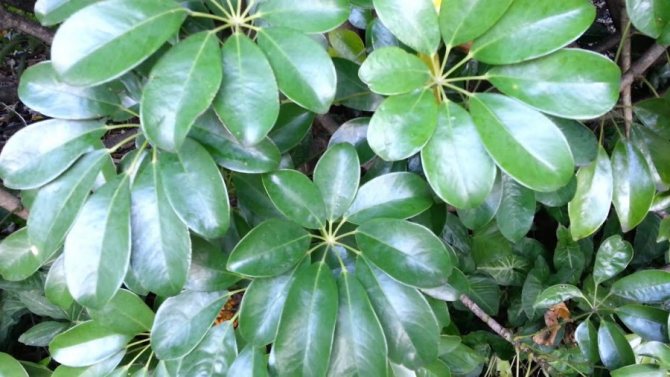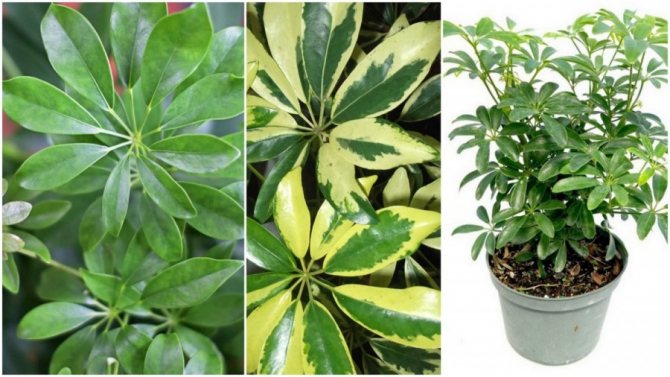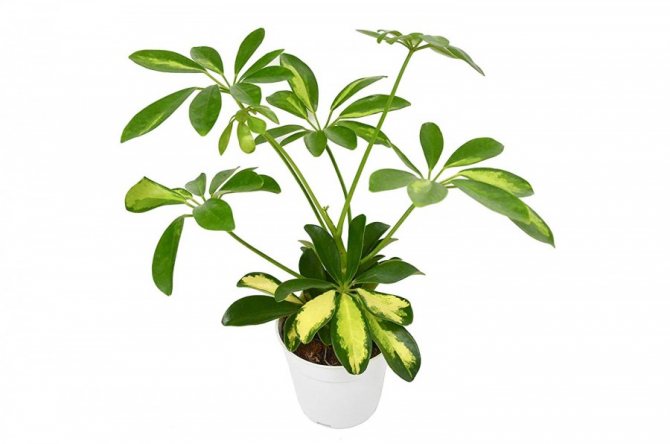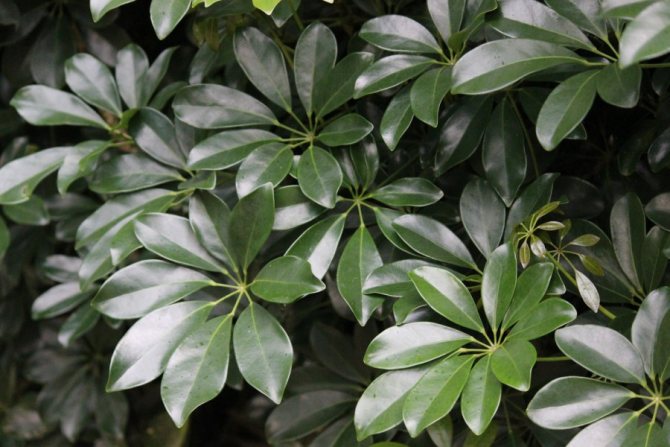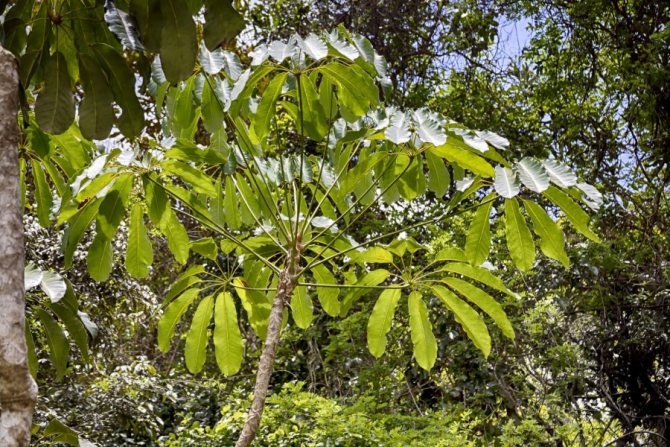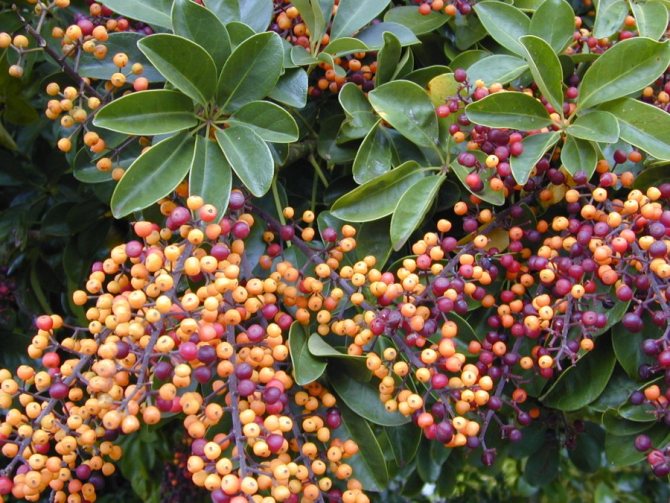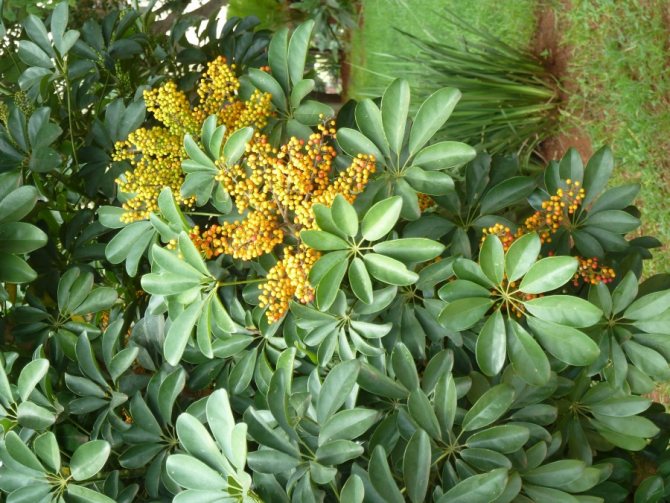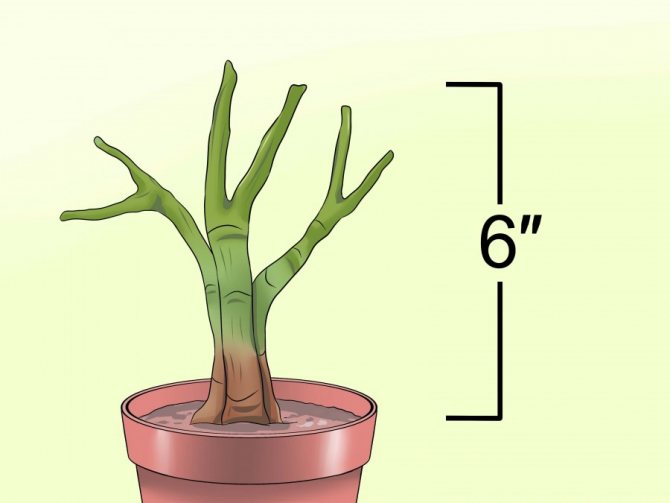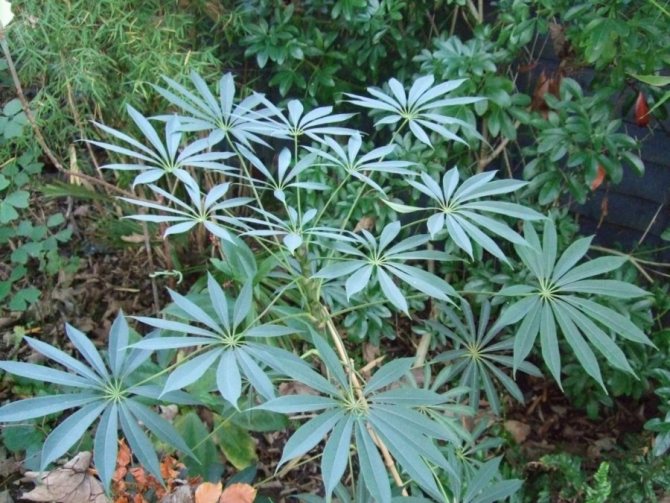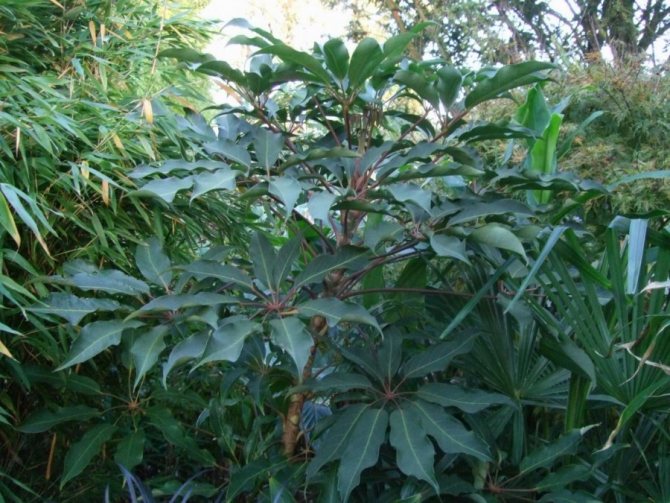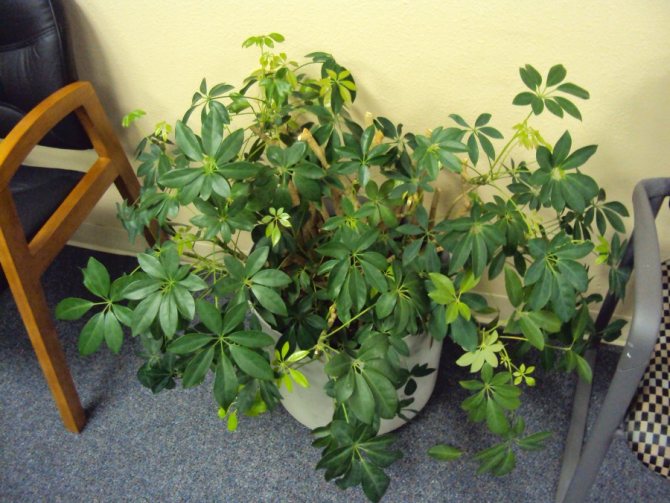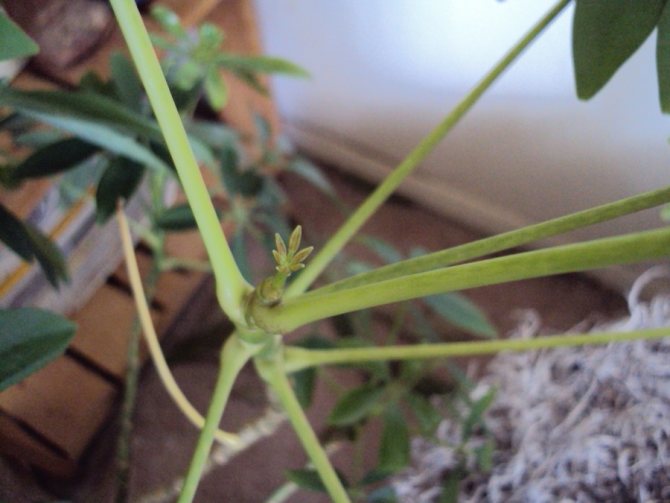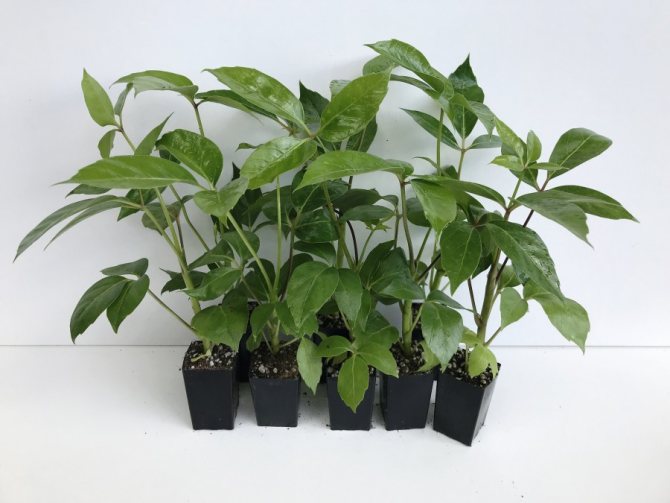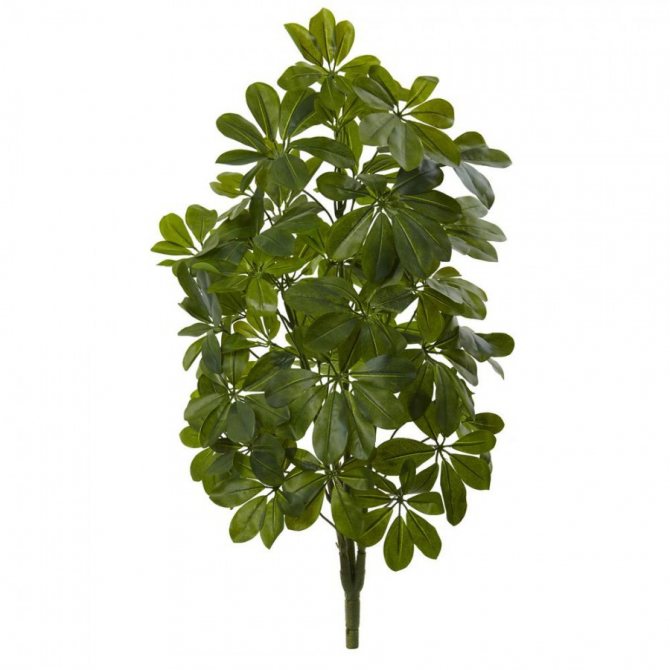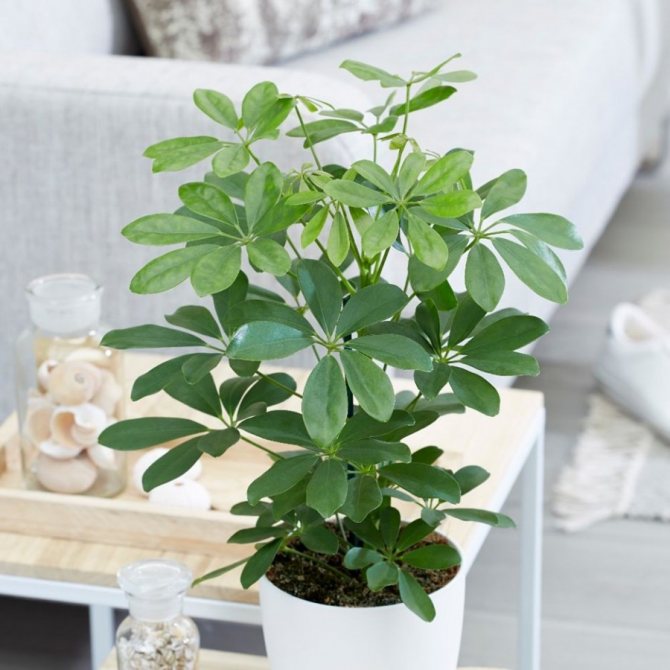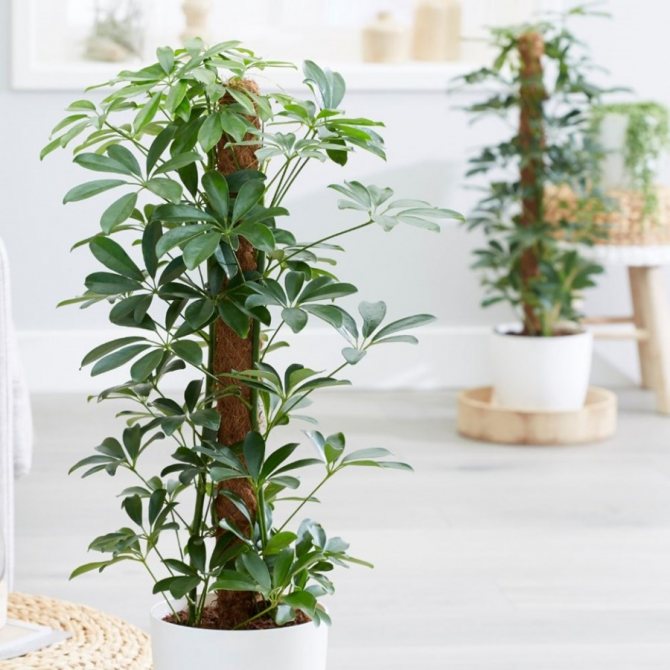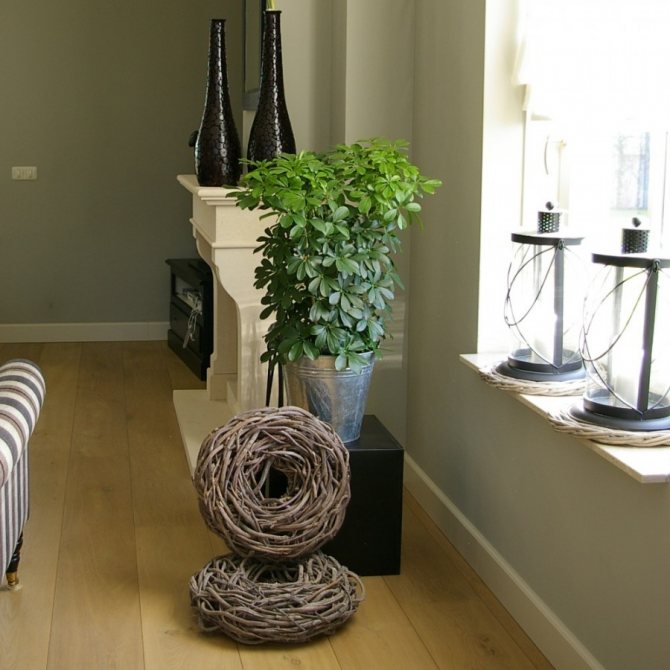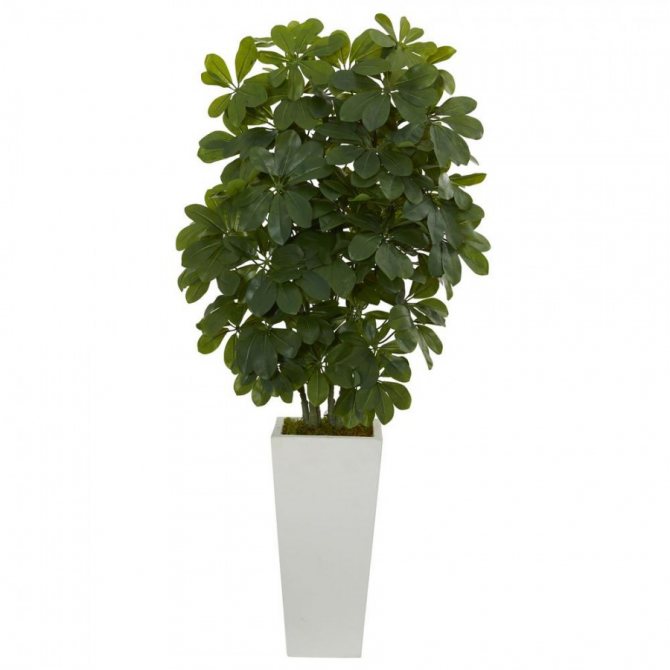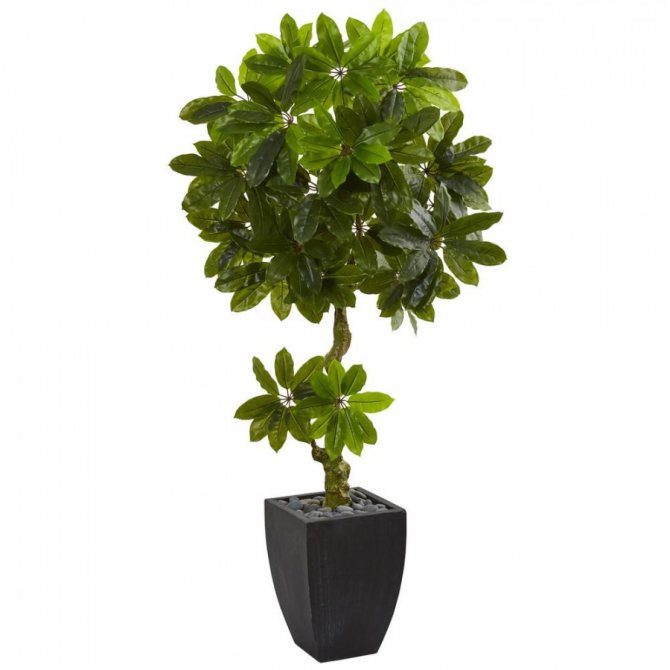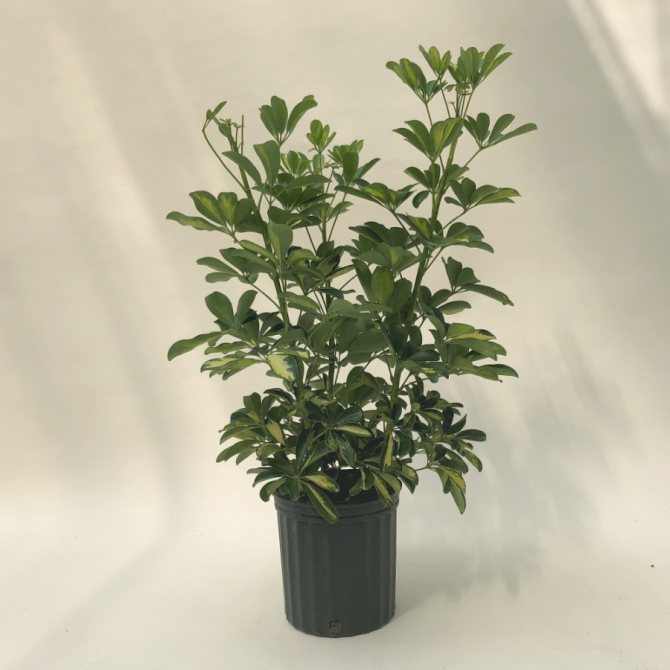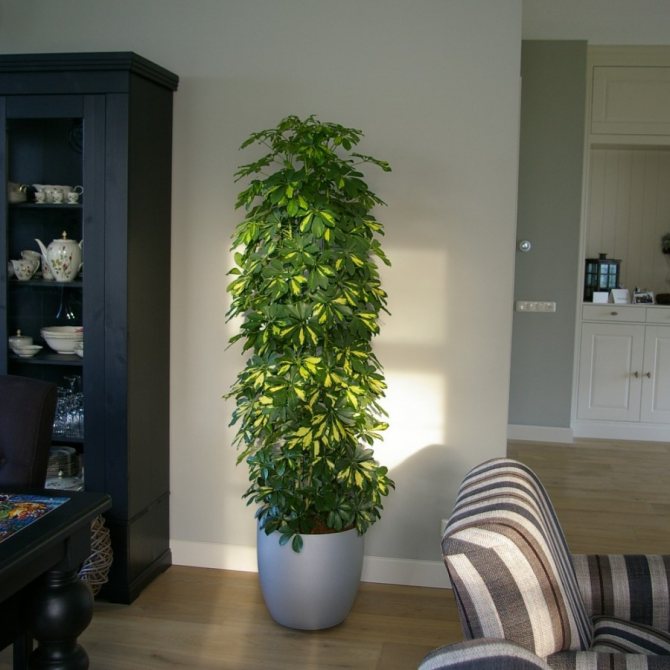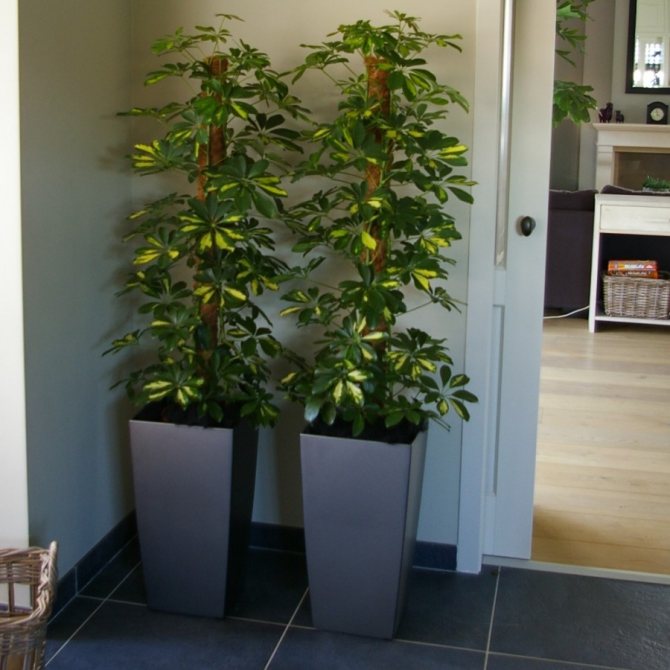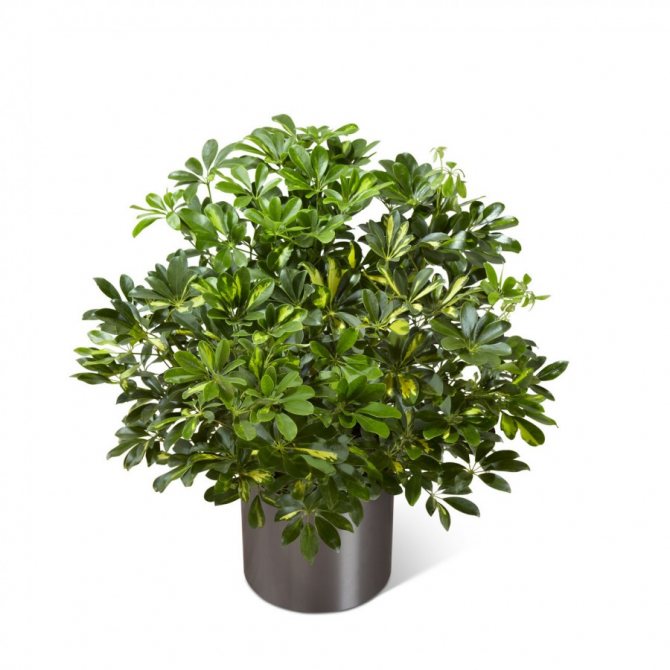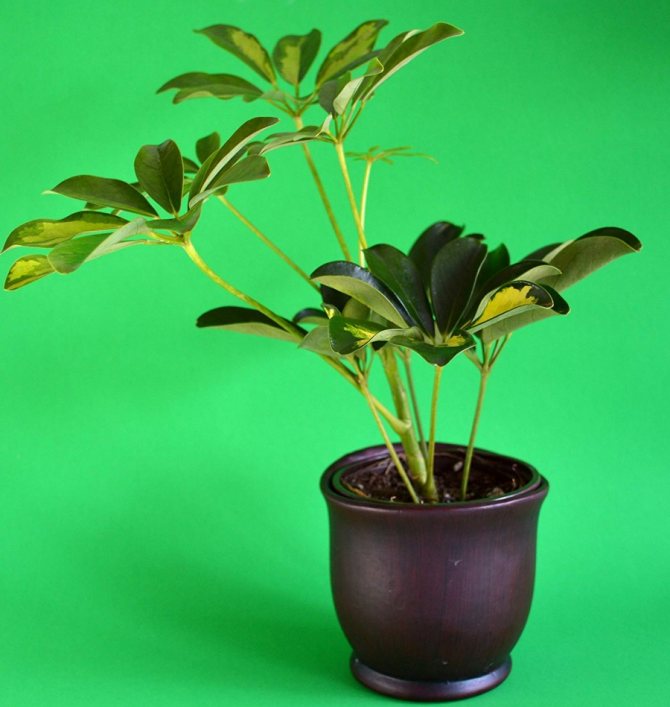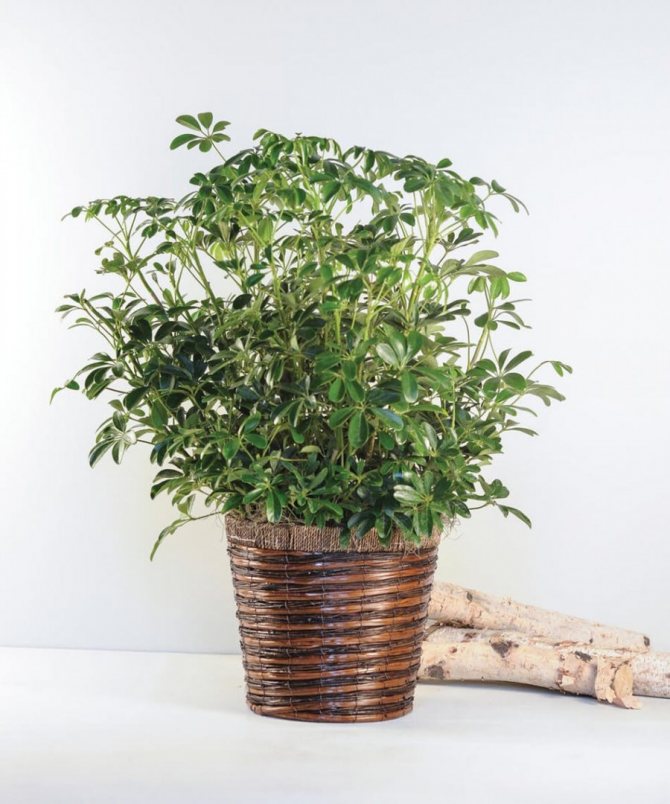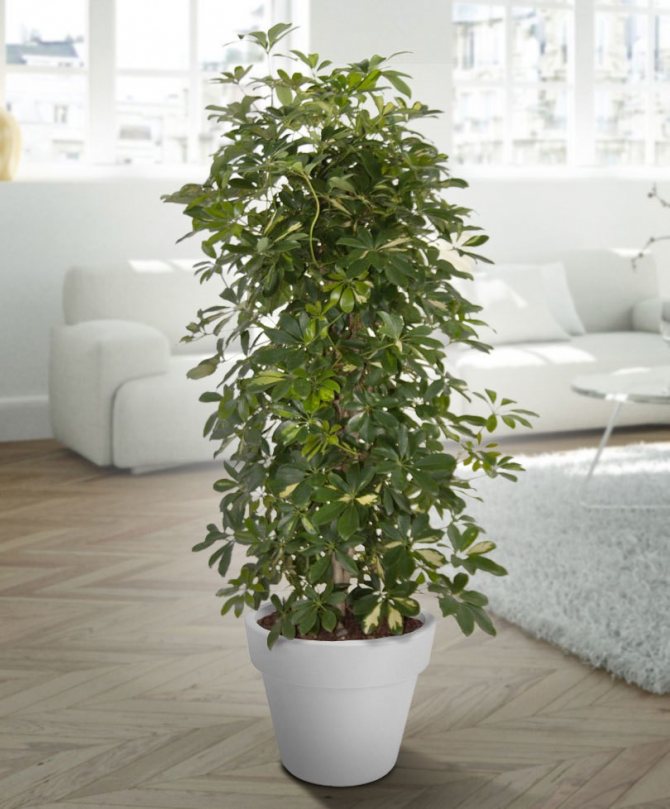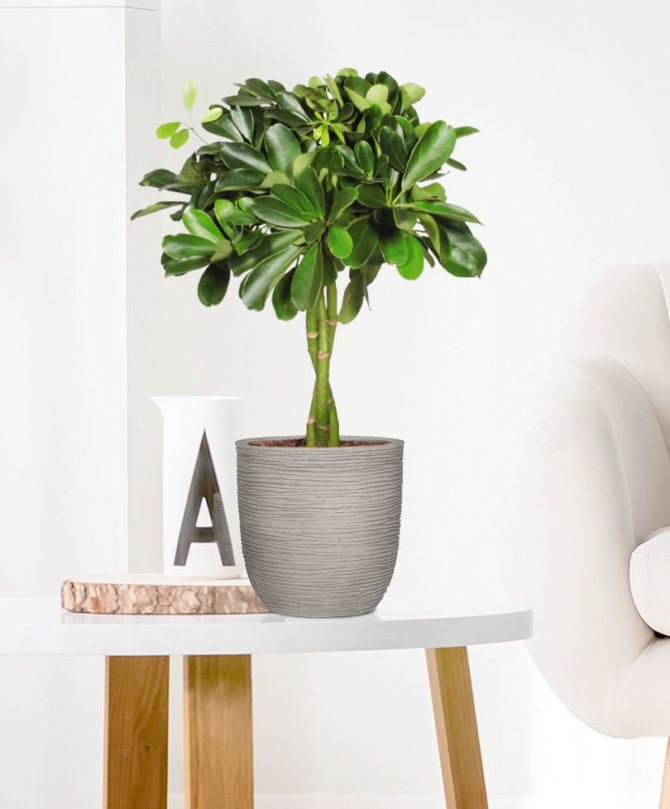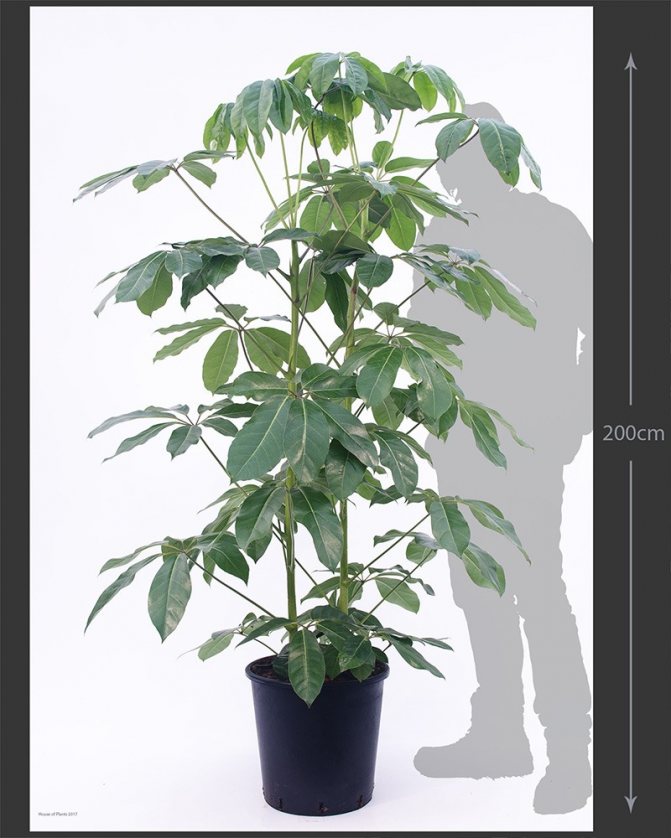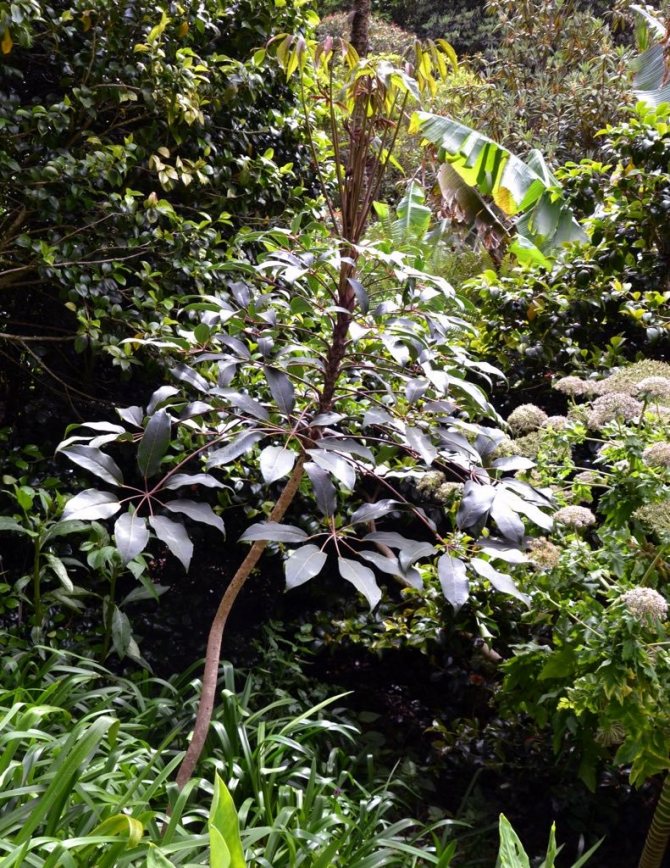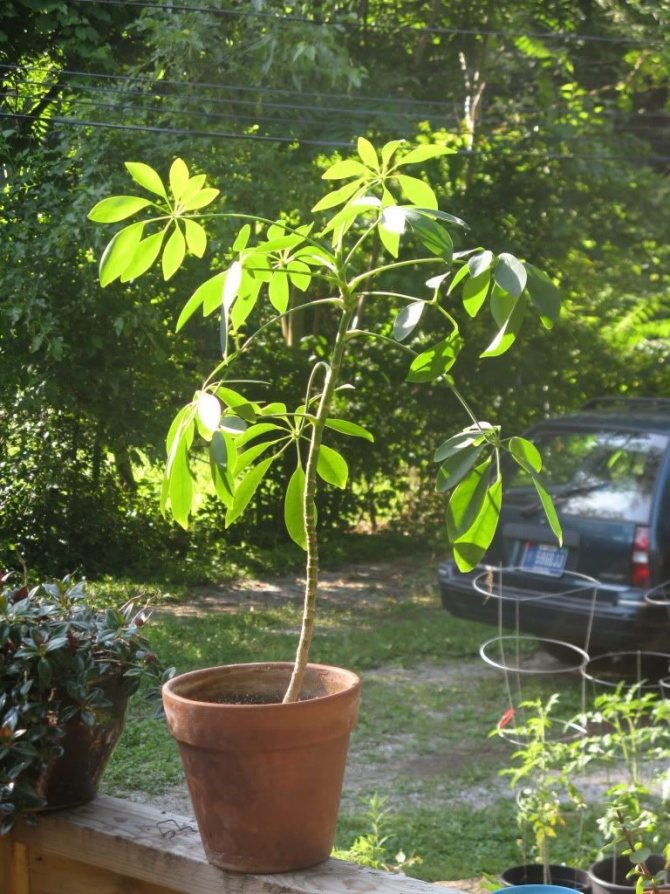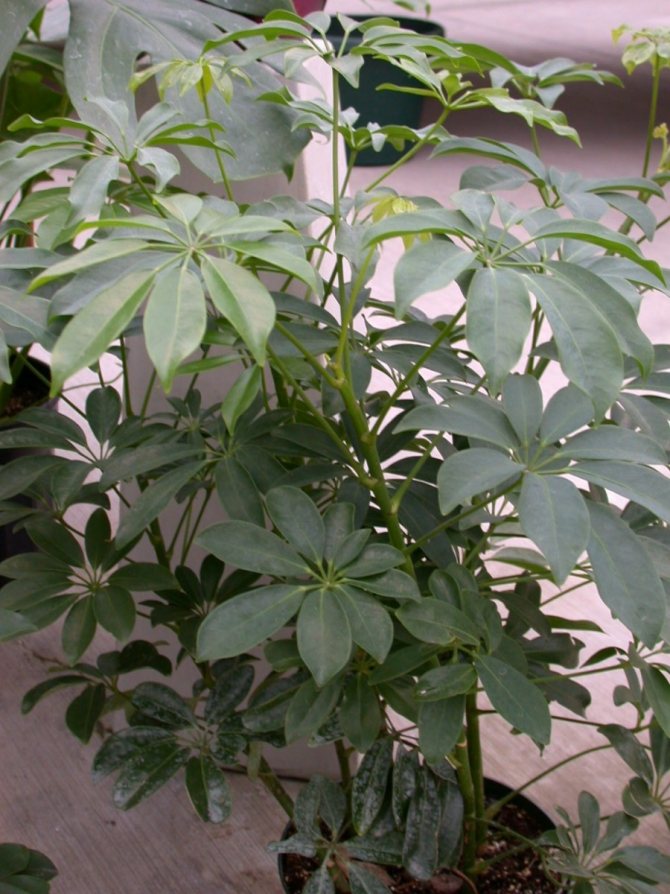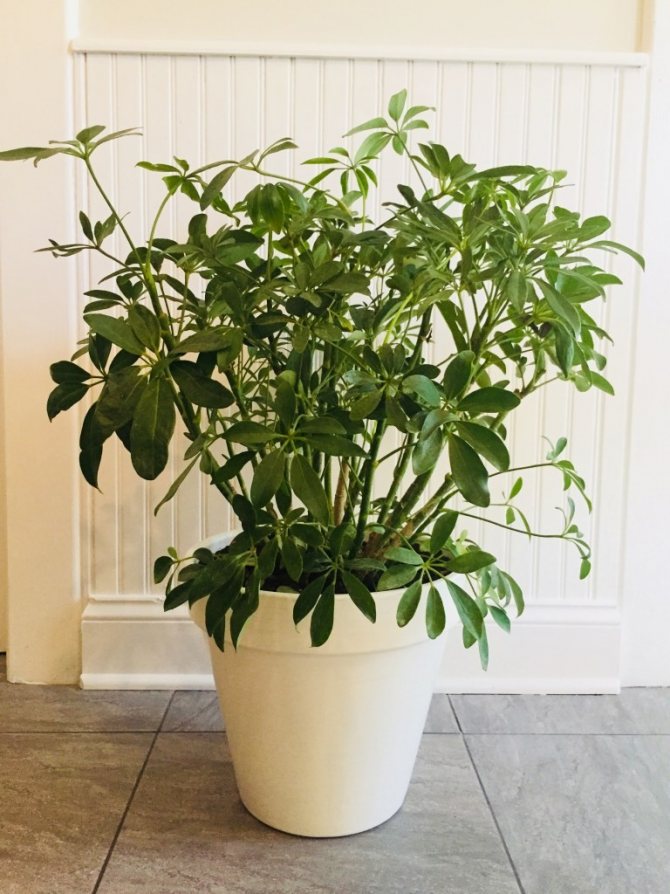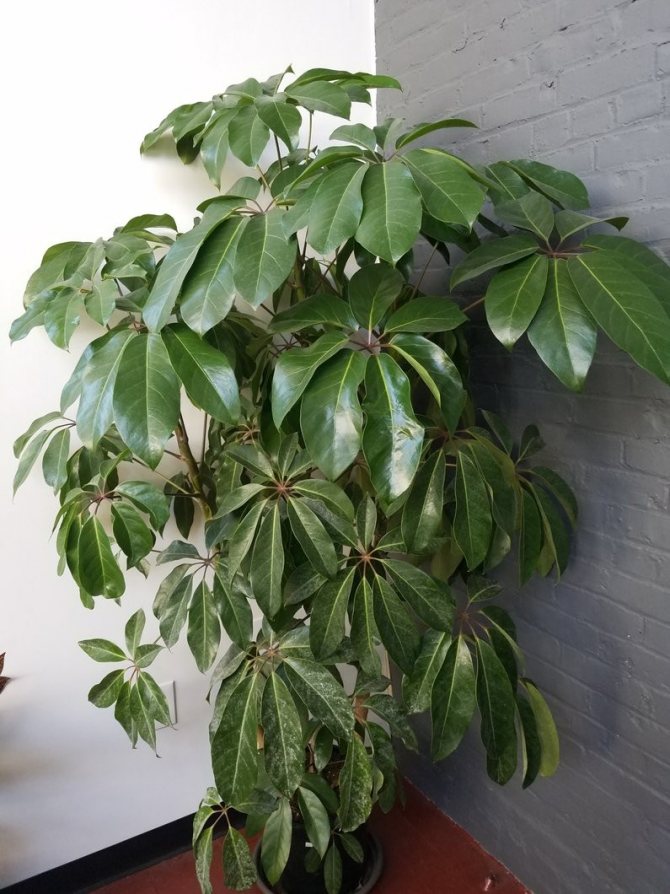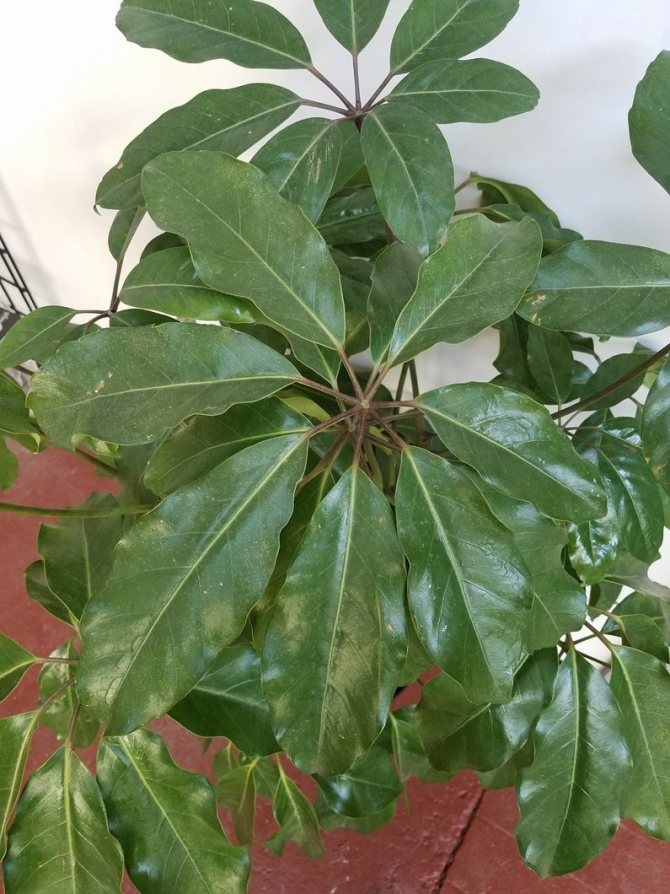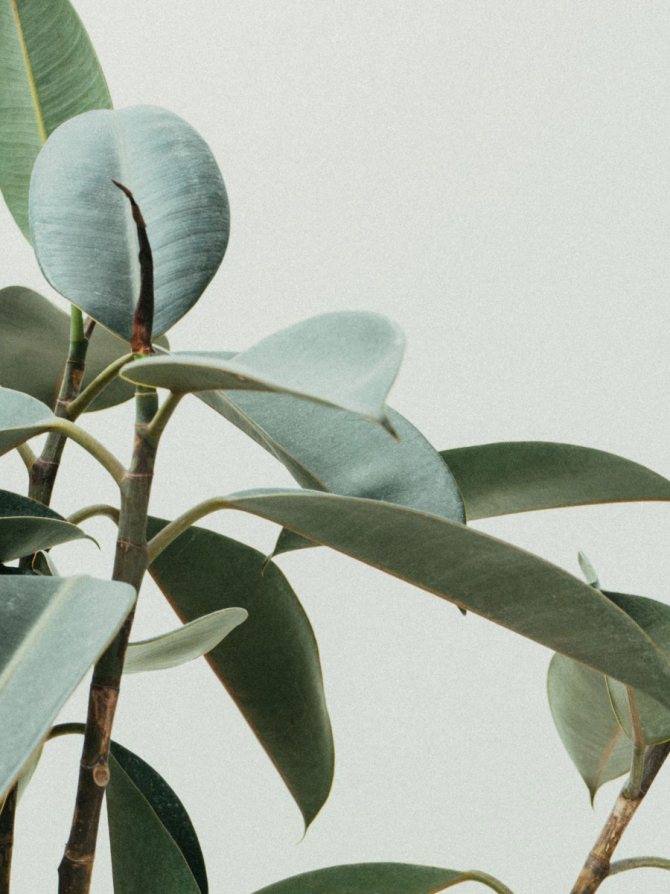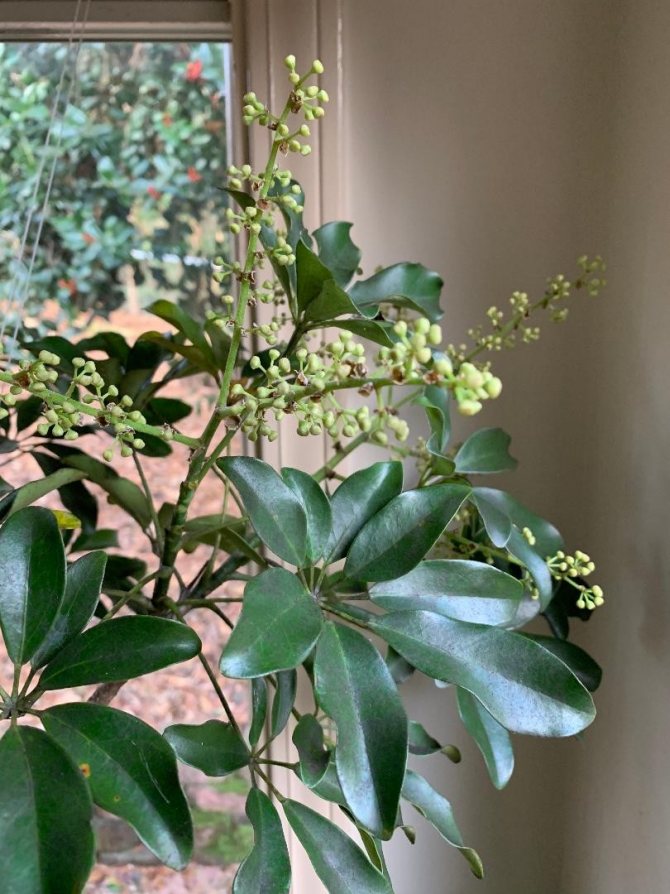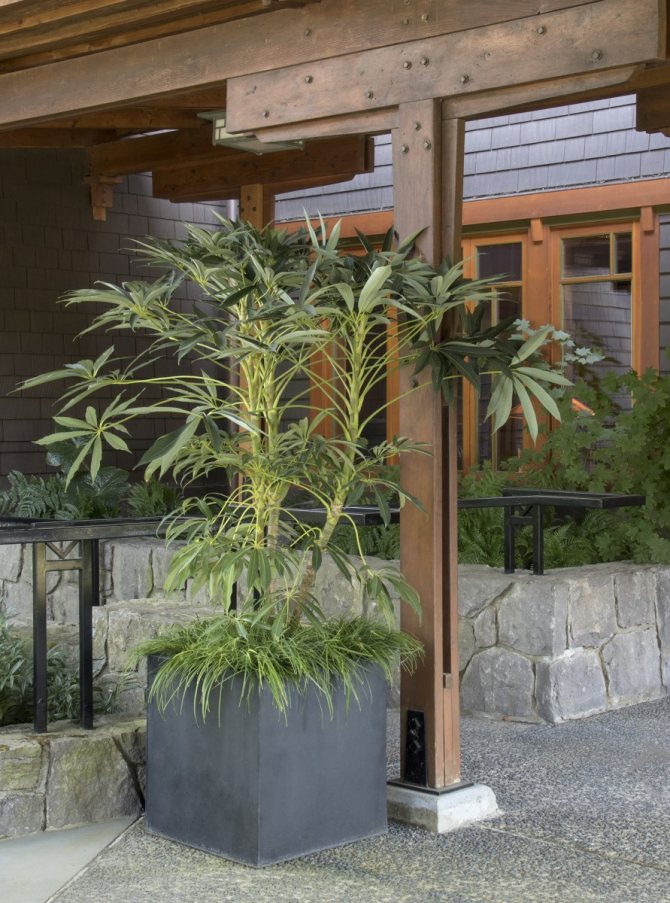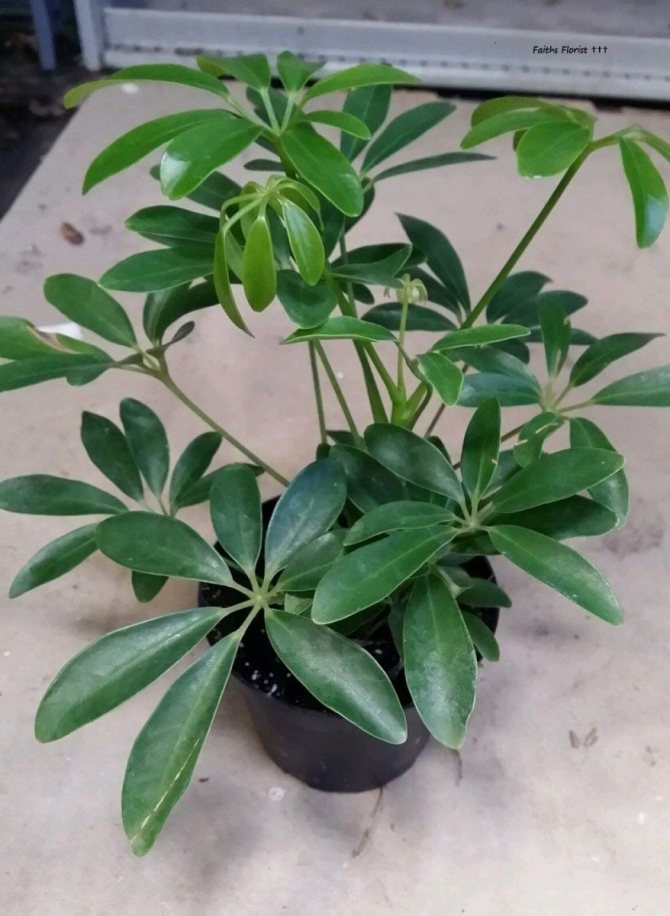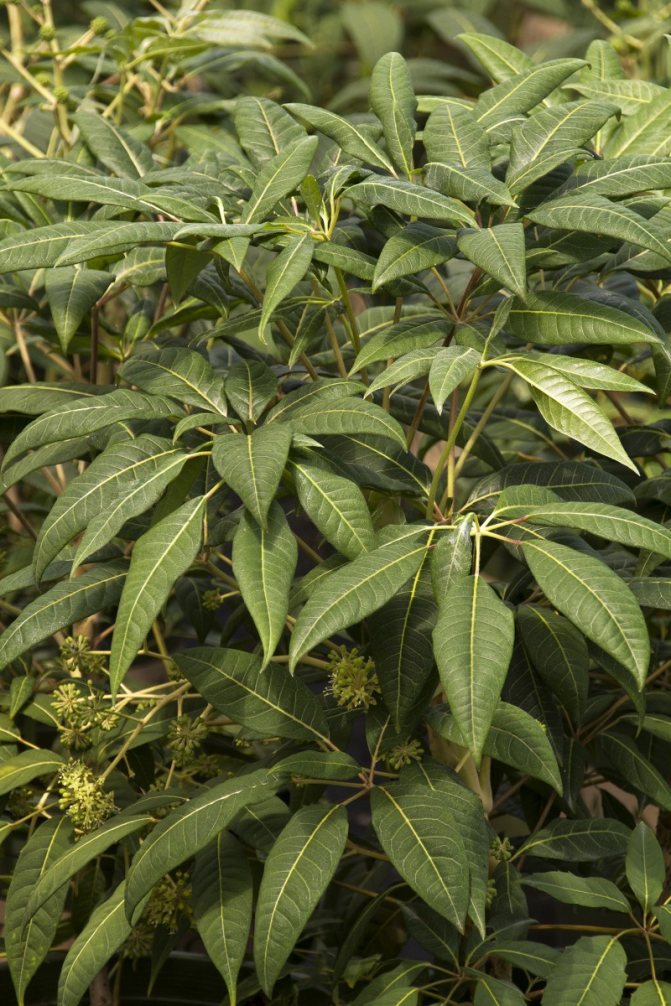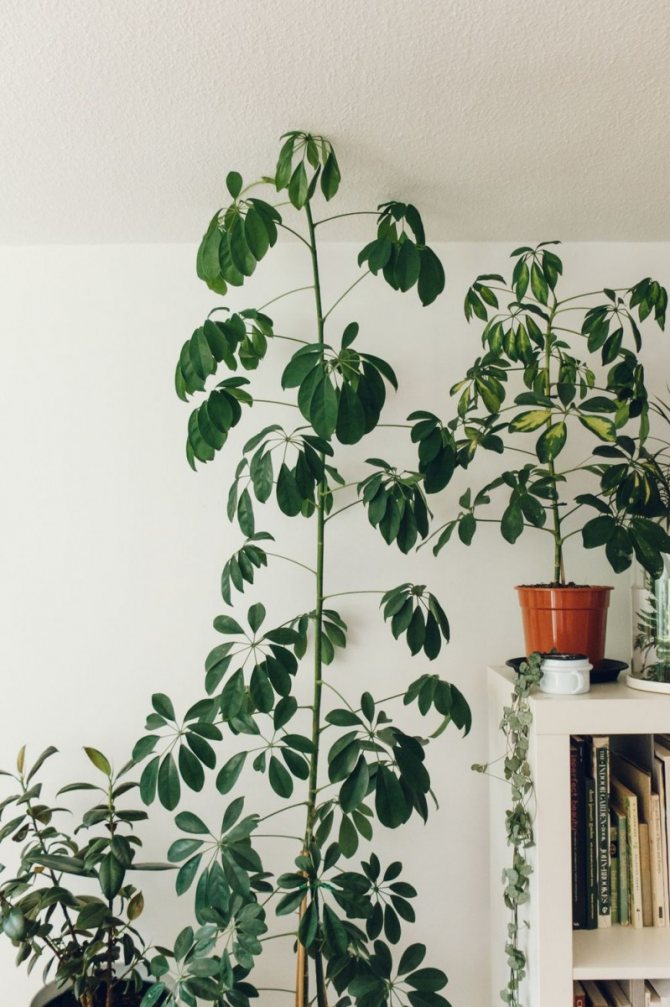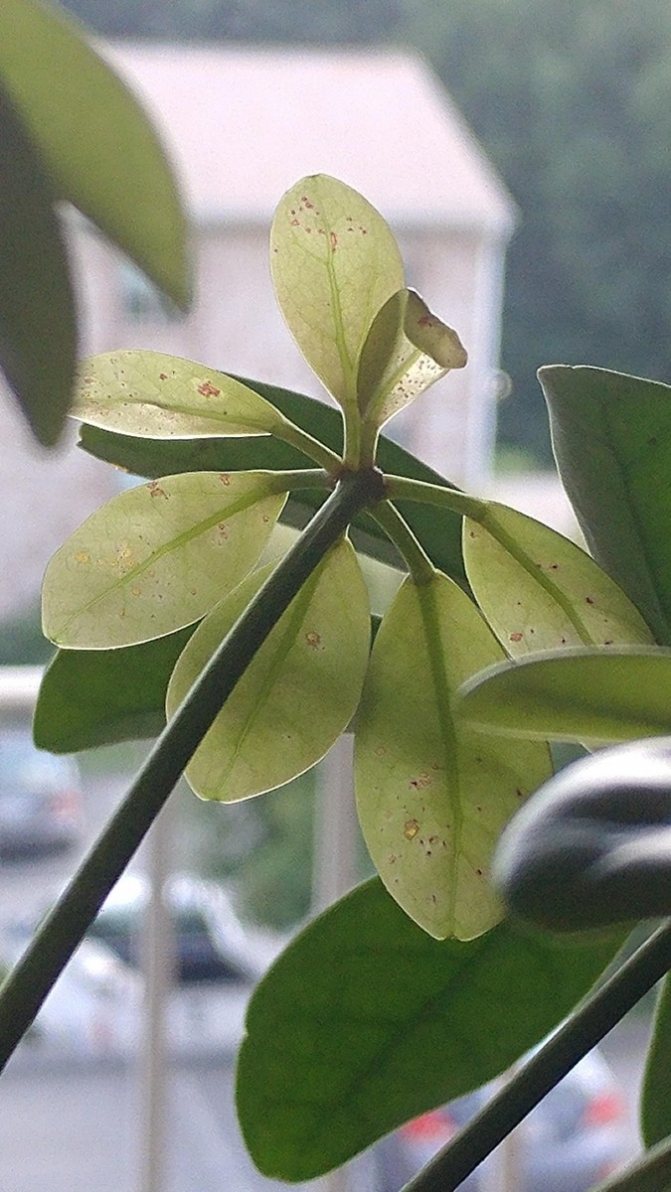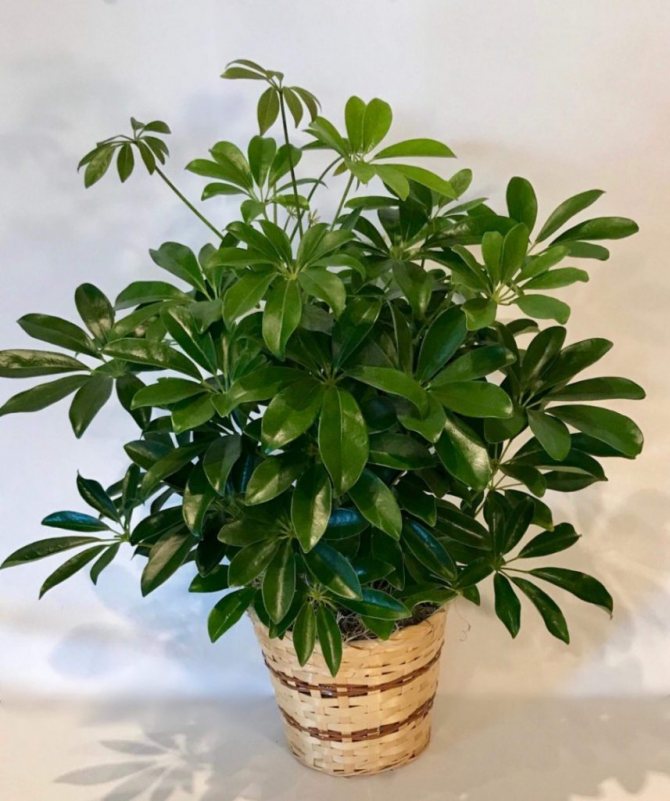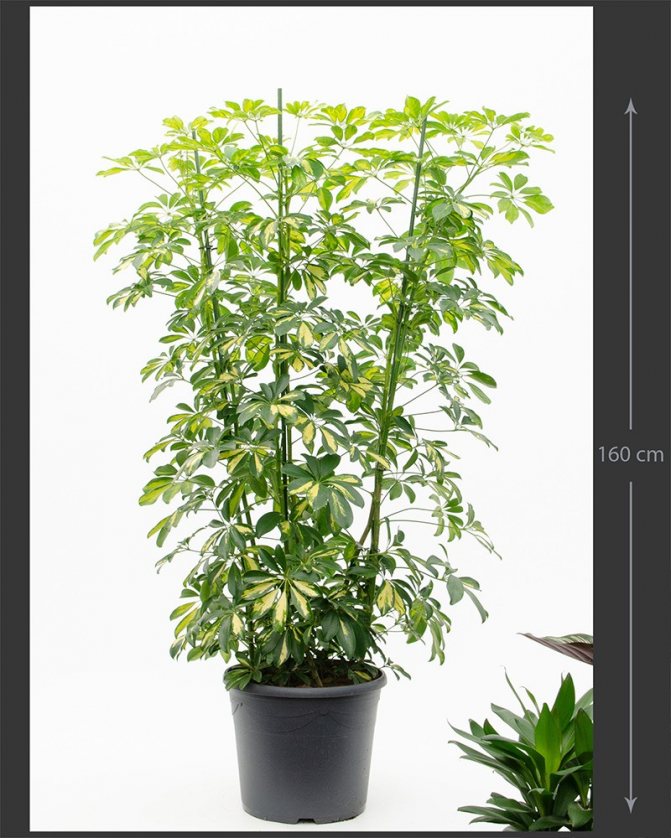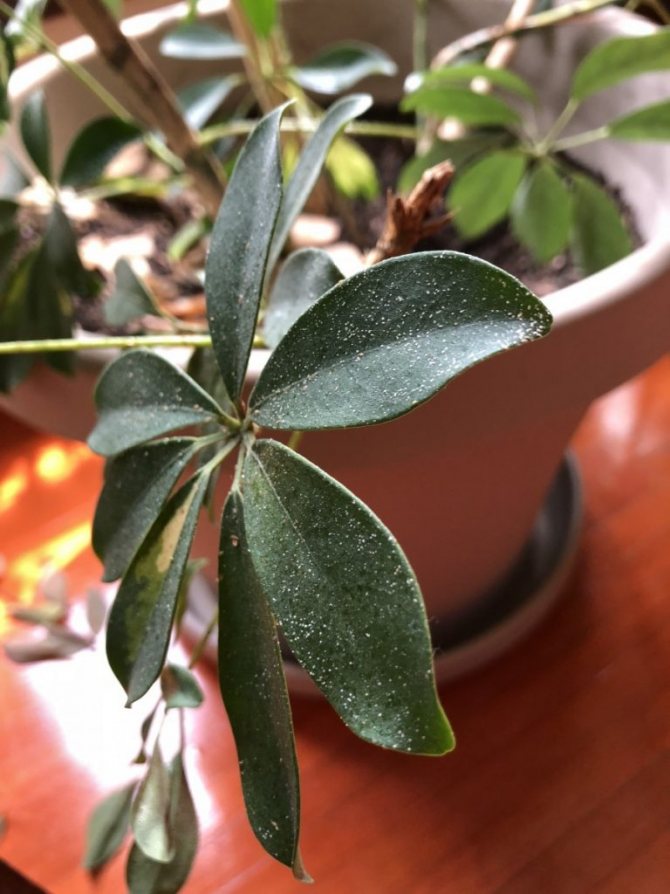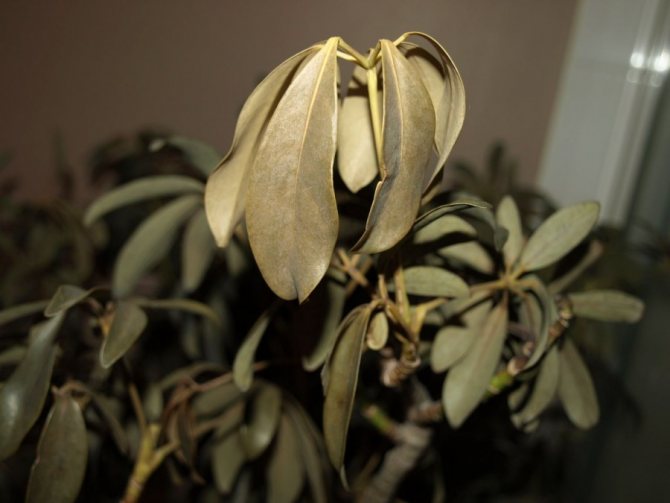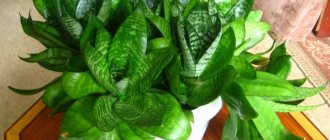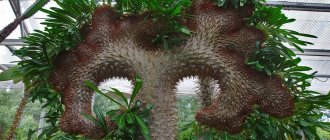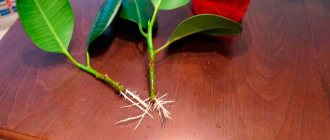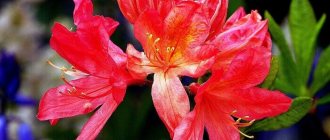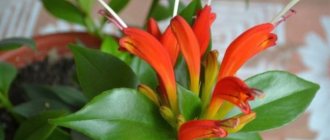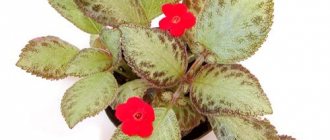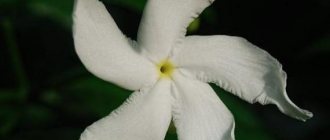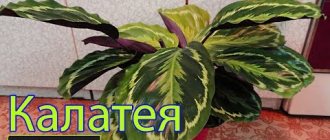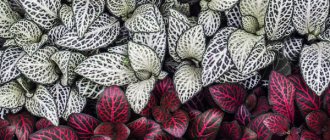A plant like cheflera or shefflera (Schefflera) belongs to a family called Araliaceae. In the wild, it can be found in the tropics in any part of the earth. And most often it is found in Australia, China, the Pacific Islands and Japan. The wild-growing shefflera is not very large trees or bushes.
This plant is very much appreciated by flower growers for beautiful, showy leaves, which are very similar to a human palm, whose fingers are spaced far apart. The leaf blades are located on a high petiole and are dissected into 4–12 lobes that grow from the 1st point. In some countries, this flower is called the umbrella of the gnomes or the umbrella tree.
The elongated racemose inflorescences of this plant are very similar to tentacles or antennae. But you can look at them only in the botanical garden, and all due to the fact that the sheffler does not bloom in indoor conditions. But she is able to decorate any room thanks to her graceful shape and spectacular foliage.

This flower is very often grown as a ficus benjamin, or rather, it is grown as a large domestic tapeworm plant, forming it in the form of a bush having a sufficiently large size or a tree.
The tall shoots of such a plant are not very thick, which is why often several young shefflers are planted in one pot at once. And then they form a common stem (intertwined). If only one tall flower is planted in the pot, then a support is usually made for it.
This plant is easy enough to grow indoors, and this is because it is completely undemanding and unpretentious. You need to take care of him in almost the same way as for other common house plants.
Note! The chefler contains substances that, once on the mucous membrane or skin, can cause irritation. Therefore, in any manipulation with it, you need to be careful.
Content
- General information
- Schefflera species and varieties
- Schefflera home care
- Watering shefflers
- Soil for shefflers
- Sheffler pot
- Sheffler transplant
- Fertilizer for shefflers
- Flowering shefflers
- Scheffler pruning and shaping
- Scheffler in winter
- Propagation of shefflers by cuttings
- Scheffler from seed at home
- Reproduction of shefflers by air layers
- Scheffler leaf propagation
- Sheffler diseases and pests
How to break up the chefler. The most famous ways.
Today, many experienced flower growers know everything about how this unpretentious and simple plant can be propagated. But for beginners in this business, our recommendations will be very useful. So, the main ways of breeding chefs at home are as follows:
- by propagation by cuttings;
- by germinating seeds;
- by means of reproduction by layering.
In addition, it is important to remember that without knowing the specifics of caring for a chefler's flower, none of these methods will give a complete guarantee of positive results.
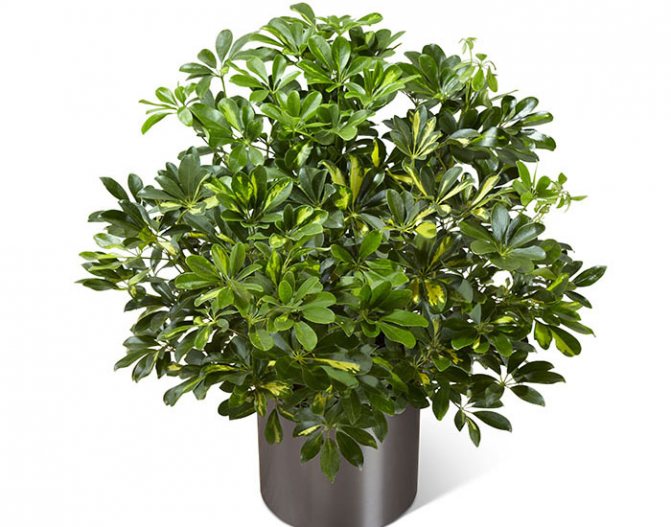

The simplest of these is breeding chefs. cuttings... To do this, we recommend using semi-lignified cuttings that are cut in the spring. Next, root the cuttings in water or take a substrate, for example, add sand (necessarily coarse grained) to ordinary soil, follow the proportions 1: 1.Before this, the places where the cuttings are cut need to be treated with a special rooting stimulator in order to root them easier.
If you use water for rooting, when the roots appear and develop (the fastest in the chefler is of a solid green color, in the variegated one after 4 weeks), plant the cutting itself in the ground, cover with a bag, having previously made a hole for air to enter. But at the same time, do not forget to remove the bag every day 1-2 times, the plant should be ventilated for 20-30 minutes.
When rooting in the substrate, the bag should be put on immediately, and ventilated in the same way. Do not overmoisten the substrate, it should be kept slightly damp.
Method two - this is the reproduction of cheflers by means of germinating seeds... Unfortunately, the fruits of their seeds are not available for chefs at home. Therefore, purchased seeds are planted in winter, mainly in January-February, and in March. The soil must be loose, airy and moisture-permeable. There are two types of soil mix you can use that work well. Peat with sand or a handful of sand and a liter of earth is recommended. About half a centimeter, the seeds go deeper into the ground. Next, pour, cover with foil and place in a place with an acceptable temperature of 22-25 degrees Celsius. It is enough to air the flower once a day, while removing the film. The pot where the seeds were sown should have a drain and a hole to drain off excess water. When seedlings appear, the plant will require a lighter habitat. Create an air temperature between 15-17 degrees Celsius. When summer comes, do not forget to spray the babies, the chefs, not with cold, but with warm water.
Breeding will be interesting layering, provided that there is a large version of this flower. When spring comes, cut the trunk of the plant. It is important to wrap the place of the incision with a layer of green moss, and then cover it with a layer of film. The moss must be moist. A month later, maybe a little later, the roots appear, and then the stem can be cut off at the bottom of the new roots and planted in soil made from mixtures of peat and sand 1: 1. When the chefs have new leaves, feel free to transplant it to its usual place.
Just a few simple rules and recommendations and the chef will happily greet you with his open palms!
Sheflera, home care. Video
General information
There are more than 200 varieties in the Sheffler genus. Not all representatives of the sheffler are suitable for growing at home, since many of them in nature can grow up to 40 meters. Houseplants are much smaller, but with good care they can easily grow to the ceiling.
The flower tolerates shaping pruning well, so the florist can give his plant absolutely any shape. Caring for a shefflera is quite simple, so even novice growers can cope with this unusual plant, growing a beautiful specimen to the envy of everyone.
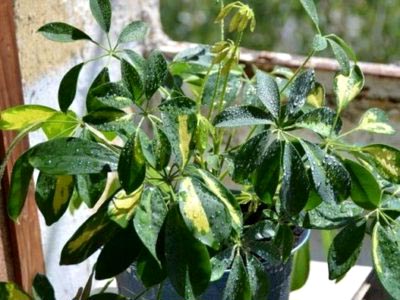

The magical properties of cheflera
It is no coincidence that the chef is used as an office plant. In addition to a neat and strict look, unpretentious care, she is able to attract money, good luck, good partners and clients. According to the state of the flower in the office, one can in some way talk about the state of affairs in the company.
Shefler is considered the flower of knowledge, therefore it is recommended to place it on the desktop of schoolchildren or students. It is believed that it contributes to a better assimilation of knowledge, understanding of the subject.
"Kind vampire" - a chef in the house or office, not only normalizes the situation, but promotes harmony between spouses and the development of normal relations in a business environment.
Schefflera species and varieties
Schefflera Gold Capella - is a cultivated form of a tree-like sheffler, grown as a house plant.Shefflers of this species are native to Southeast Asia. The plant is a small tree with a straight trunk that resembles a palm tree. The height of the flower reaches 120 centimeters. It has lush, bright green foliage with golden spots.
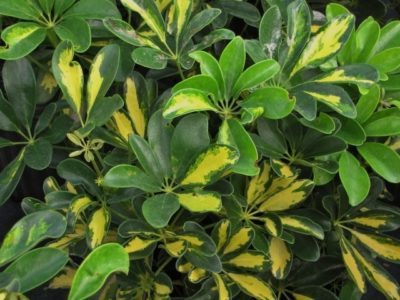

Schefflera Nora - is an indoor plant variety, which is distinguished by an elegant foliage and unpretentious care. The flower has long and narrow leaf plates of a green hue with bright yellow dots. The edges of the leaves are decorated with even teeth. Schefflera has a lush crown and dense foliage.
Schefflera Janine - has all the advantages of its kind and is as unpretentious in care as the rest of the shefflers. Among others, it is distinguished by elegant, variegated foliage. Dark green leaf plates are diluted with light specks and stains. Janine normally treats the shade and does not lose the variegation of the color of its leaves.
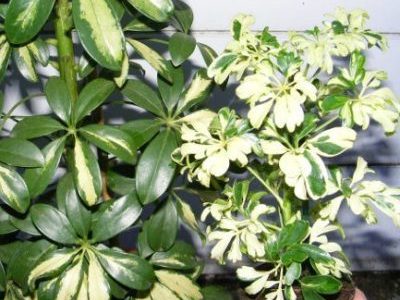

Scheffler Gerd - is easy to clean. The plant will be comfortable on a windowsill with diffused lighting. It reaches a height of 50 centimeters to 2.5 meters. He needs a moist and fertile soil. The leaf plates of the plant are variegated, having a pale green or yellow-green color.
Scheffler Louisiana - the most graceful representative of her kind. It has openwork, leathery, shiny leaf plates that have an unusual decorative effect and a motley green-yellow tint.
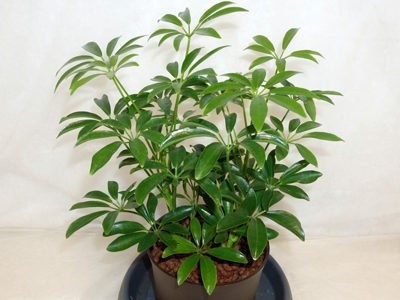

Schefflera Bianca
This variety differs from the rest in shorter leaves, which reach up to 8 centimeters in length. Each leaf plate has a white edging and beige blotches at the base. Due to the contrast of dark and light shades, decorative notches that adorn the edges of the leaves become almost invisible.
Schefflera tree (Scheffler arboricola) - is a flowering shrub, the homeland of which is considered to be China. In nature, it has a straight trunk and reaches a height of up to 4 meters. The plant has complex, palmate, large leaf plates of a light green hue.


Schefflera Caster - the plant has decorative dimensions, so it will be ideal for growing in an apartment. It reaches a height of up to 120 centimeters and has medium-sized, dark green, leathery, shiny leaf plates.
Schefflera Radiant (Schefflera star-leaved) - is the most common type of plant. In nature, the sheffler reaches a height of 15 meters and can have one or two trunks. When growing a tree at home, it will grow up to 2.5 meters in height. It has dark green, leathery, shiny, large, jagged leaf plates. Shefflera blooms with small red inflorescences.
Schefflera Mundrop
It is one of the smallest species. It is home to Asia, China and Australia. The plant has several trunks, on which are palm-compound leaves with a green color and yellowish or white spots.


Schefflera Amate - the plant can grow up to 2.5 meters in length and has shiny, large, feathery, waxy leaf plates of a dark green hue. The flower is resistant to pests and tolerates shade well, therefore it is suitable for apartments with windows facing north.
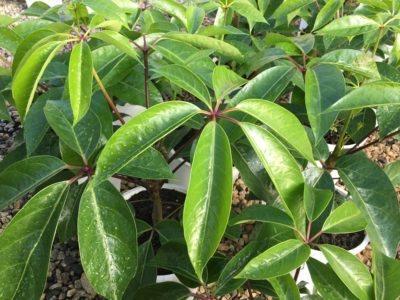

Sheffler Melanie - belongs to the genus treelike sheffler. It can reach a height of up to 1.5 meters. Has a lush crown with olive, shiny, large leaf plates with dark green stains. The plant is unpretentious in care, therefore it is suitable for beginner flower growers.
Schefflera Variegated - This plant grows up to 1.5 meters in length and has dark green feathery leaf plates with olive streaks and intersperses. It is unpretentious to care for and is practically not susceptible to attack by pests.
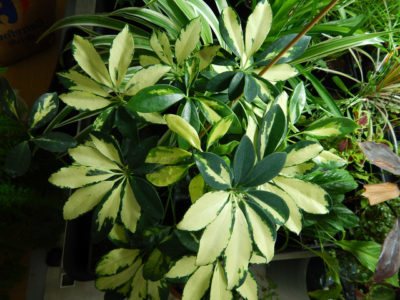

Schefflera spotted
The plant of this variety is distinguished by its unusual decorative leaves, which are large in size and a dark green shade with yellow spots and serrations along the edges. The flower is easy to care for and is suitable for growing in apartments and offices.


Scheffler Charlotte - this species was bred relatively recently. The plant has unusual leaf plates, the outer part of which has a light shade, the edges are decorated with a dark green edging, and the reverse side of the leaf plates has a rich dark green hue. The plant resembles a palm tree, is easy to care for and has high decorative qualities.
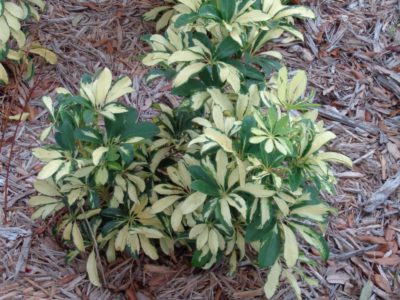

Scheffler's eight-leafed - This plant species grows in the wild in China, India and Japan. The height of the tree reaches up to 2 meters. Its leaves are covered with small, light-colored needles that fall off over time. Each leaf has eight large oval-shaped green leaf plates.
Scheffler's finger - the birthplace of the plant is New Zealand. In nature, it grows in tropical forests, where it reaches a height of 8 meters. Its leaf plate is divided into 7 parts that resemble the fingers of a human hand. The leaves have pointed edges and a dark green tint.
The inflorescences of this sheffler variety have a paniculate shape. They are quite large and reach a diameter of up to 40 centimeters. After the plant fades, fruits appear in place of flowers, which are eaten by tropical birds. Schefflera is listed in the Red Book, as local residents sell young shrubs to tourists, thereby reducing its number.


Types of chefs
There are about 200 plant species in the wild. Let's dwell only on those that are grown indoors.
- shefler's eight-leafed... The most common plant. It presents a bushy form with leaves that look like spread fingers. The shape of each leaf is lanceolate, with lighter veins than the leaf itself. Plant height is small, up to 50 cm. There are varieties with variegated leaves. If there are several seedlings in one pot, they form a lush spreading cap;
- cheflera tree - has the shape of a small tree, with green or spotted leaves extending from the trunk. It is desirable to have a support for this type that will support and guide the thin trunk;
- sheflera radiant - most often has 7 leaves and grows in the form of a small tree. The color of the leaves is predominantly green;
- business sheflera - plant height in indoor conditions is no more than 40-45 cm, has an interesting and larger oak leaf shape. The color of the leaves can be either green or spotted.
Schefflera home care
Schefflera is very light-requiring. At the end of autumn, the plant should be moved to a windowsill facing the south side of the house. There it should be until spring. In summer, the plant needs shading so that direct sunlight does not fall on it.
If there is little light in the apartment or house, then it is better to choose those varieties of shefflers that tolerate shade well and have green foliage. Variegated varieties in this case are not suitable, since they require a lot of light to preserve decorativeness. In summer, the plant must be taken out into the street, placing it in a shaded area.
Sheffler will be comfortable if the grower in the room provides her with high humidity, although she can adapt to normal humidity. The plant needs regular sprinkling, which is carried out with warm, settled water.
The tree will grow and thrive at room temperature. In the winter season, temperature indicators should not drop below + 12 degrees. There should be no drafts in the room with the shefflera, and it should not be placed next to the battery. However, small temperature drops will benefit the plant.
Heptapleurum is also a member of the Araliev family. It is grown when nursing at home without much hassle, if you follow the rules of agricultural technology. All the necessary recommendations can be found in this article.
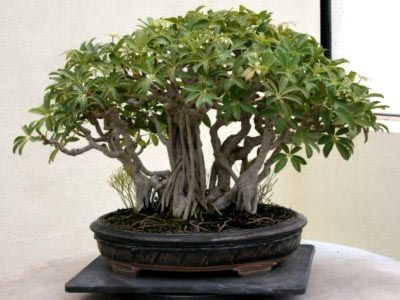

Choosing optimal conditions and temperature conditions
If you do not want to wonder why the chefler is not growing, you just need to remember a few simple rules. Create a habitat that makes the chef flower more than comfortable. The best place for him will be window sills windows facing west and east. In the absence of such an opportunity, it will be enough to place it right next to the window, so that diffused sunlight falls on the flowerpot. It must be remembered that this delicate plant is worth avoid drafts... It is also an excellent condition that there are air conditioners in your home or office space. This will give a chance to make the optimal temperature the room is 18-22 degrees Celsius and the flower will grow much better and faster. But if there is no air conditioner in the room, you should know that then the flower needs to be additionally watered and sprayed with water.
Watering shefflers
The tree should be watered systematically, not overwetting the soil too much. Standing water at room temperature is best suited for watering. Care must be taken to ensure that the ground does not dry out.
In winter, when the plant has a dormant period, watering should be reduced. It is impossible to allow waterlogging of the mixture to the ground, its acidification and stagnation of water, otherwise the sheffler will die.


Preparatory work
Before replanting, you need to prepare a pot of the right size with a high-quality substrate. Given the large size of an adult plant, the pot will have to be changed several times during its growth. Therefore, it is not necessary to plant immediately in a large container - replacing the place of residence and renewing the soil will have a beneficial effect on the sheffler. The soil for planting needs soft and non-acidic so that the seedling takes root, and does not fight stony or excessive acidity of the soil. The land purchased in specialized stores does not require additional processing, but the mixture collected on your own must be watered with a weak solution of potassium permanganate and treated with fungicides and insecticides. High-quality growth is laid from the beginning of the flower's life, so the pot with the seedling should be on the windowsill where it will receive a sufficient amount of diffused sunlight. You need to worry about free space for new inhabitants of the window in advance.
Soil for shefflers
The soil for the plant should be nutritious and light, only in such a substrate will it feel comfortable.
The mixture can be prepared on your own or you can buy ready-made land in the store, giving preference to the soil for growing ficuses. To prepare the soil at home, you need to take sod, humus and river sand in a 2: 1: 1 ratio.
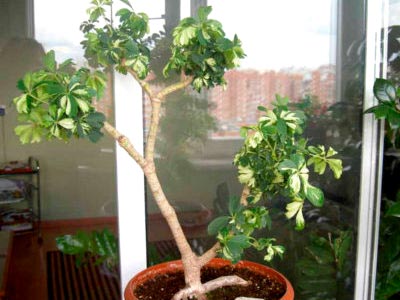

How to transplant to the chefler
Transplanting chefs at home is a simple matter.
The flower chefler needs to be transplanted only once every 2-3 years. The best seasons for this process would be spring or fall. A transplant can be done more often only when you see that the plant is capable of very fast growth and reaches a decent height. The choice of a pot plays a big role, it is better to let it be large and voluminous, it will give the flower the opportunity for rapid growth. A pot with holes is an ideal choice, this is necessary so that when watering, excess water flows into the pan.
And, of course, do not forget about the composition of the soil. For transplanting cheflers at home, make a mixture of 3 parts of soil (a greenhouse or compost one is good), mixed with 1 part of peat and 1.5 parts of sand (it is advisable to choose a larger one). It will be good to use a special wooden stick to distribute the substrate evenly throughout the pot.Be sure to provide good and strong drainage for proper flower growth and development.
Sheffler pot
Having prepared the soil mixture, you should choose the right pot for the plant. Everything here will depend on the age of the plant. For example, small pots or even plastic cups are suitable for seedlings.
But, when the roots grow, they should be transferred together with a lump of earth into pots with a diameter of 9 centimeters, and in the fall they should be transplanted into pots 12 centimeters in diameter. With each subsequent transplant, the diameter of the pot must be increased by 3-5 centimeters.
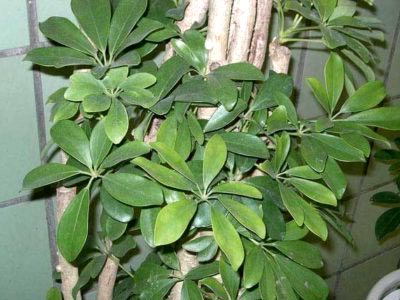

Landing
Shefflera seeds are planted in the second half of winter: from mid-January to the end of February. Before planting, seeds are soaked in a stimulant (in accordance with the instructions in the instructions), for example, Epine or Zircon, to accelerate germination.
Seeds are planted in a disinfected soil, consisting of sod and leafy soil with the addition of sand, all components are taken in equal parts. The second variant of the planting mixture is sand mixed with peat in a one-to-one concentration.
The seeds are placed at a depth of five to six centimeters. The distance between adjacent ones should be twice their size.
After planting, the soil is periodically watered, not allowing it to dry out, and the room temperature is maintained in the range from + 20 ºC to + 25 ºC.
The pot can be covered with plastic wrap to create a greenhouse effect, in which case the plant needs regular ventilation.
Transplanting seedlings into pots is carried out when the first three leaves appear on them. It is very important for the first three months after transplanting to keep the sheffler seedlings at a temperature of +19 ºC.
Location and lighting
Lighting is very important for the sheffler, so the best location for her is on the windowsill of the east, west and north windows. Schefflera
should stand in the brightest part of the room.
Please note that variegated sheffler varieties may lose their expressiveness due to lack of light, so even the northern windows are not sufficiently illuminated for them.
The location on the southern windows should be treated with caution, as the plant can be hot on them, and exposure to sunlight can lead to leaf burns.
If the windows of the room face south, the sheffler will have enough lighting on the table, standing near the window.
With a lack of lighting, the sheffler stops its development, and sometimes even dies, therefore, in low natural light, use fluorescent lamps.
Pot size
The size of the pots is chosen depending on the age of the plant. Seedlings are planted in small containers, which can be plastic cups. When the root system of the plant takes up all the space, the sheffler is transplanted into a pot with a diameter of 9 centimeters, and by autumn - 12 centimeters in diameter. For subsequent transplants, the size of the pot should be 3-5 centimeters larger than the previous one.
The soil
Soils for planting shefflers may vary slightly in composition, but they must be nutritious, light and breathable.
An adult plant can grow in the same soil in which the seeds were planted: a peat-sand mixture or a mixture of sand with sod and leafy soil.
For an adult sheffler, you can prepare a new mixture: 2 parts of sod land, 1 part of leafy soil, 1 part of river sand and 1 part of humus.
If you do not want to prepare the soil yourself, a ready-made mixture is sold in the flower shop; the soil for ficuses is best suited for the sheffler.
Transfer
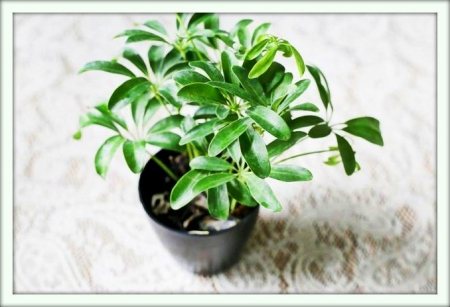

The frequency of transplanting a sheffler depends on the plant: grown from a sheffler seed, it is transplanted in the first year of its life, about six months after planting. Small developing plants are transplanted every two years, and large ones - not more often than once every three years, but better - at five years.
Young plants need to be replanted more often due to the development of the root system, which quickly takes up the entire space of the pot.
The new pot should not contain voids, so the soil is pressed tightly so that the roots fit snugly to the ground.
When transplanting, expanded clay drainage should form at the bottom of the pot.
When the plant is transplanted, it must be watered well.
Large plants are transplanted while maintaining the formed soil coma. For them, only the top layer of soil changes, for this the top ten-centimeter layer of earth is removed and a new one is introduced in its place.
The safest way to transplant a branched sheffler is the transfer method.
Fertilizers and feeding
Top dressing of shefflers is carried out only with liquid fertilizers. Fertilizers should be for indoor plants, and the frequency of feeding depends on the season. In the period from October to March, the sheffler is fertilized every two months, and the rest of the time - every three weeks.
The concentration of fertilizers recommended on the package is not always suitable for the Scheffler, so if you are not familiar with the fertilizer, prepare a solution of a weaker concentration. It is much safer to make the fertilizer concentration 5 times weaker, but apply it twice as often.
A fairly popular method of fertilizing the Scheffler is weekly during the summer with a mixture 8 times weaker than the recommended one.
Dry feeding for the sheffler is undesirable, and fertilization with chopsticks is fraught with an overdose.
Watering
Shefflers will be successful if only the plant is properly watered.
The soil should always be slightly moistened, while watering the plant should be moderate.
If we talk about the extremes, the sheffler tolerates overdrying better than waterlogging. If the soil contains a lot of moisture, the leaves of the plant will begin to turn black.
In warm weather, in addition to watering, plants are additionally sprayed with soft water.
In winter, the sheffler does not develop as quickly as in summer, so watering is reduced. The difference in temperatures is compensated for by spraying, that is, if the temperature in the room is the same in both winter and summer, then the watering is reduced, and the spraying remains the same.
Temperature


The temperature of the room in which shefflers develop best is between +18 ºC and +23 ºC. At the same time, shefflers are not picky and develop well under normal conditions, the main thing is to carry out timely spraying and maintain a good microclimate.
Sheffler transplant
A young tree should be replanted in the first year of its life. This is extremely important for proper growth and development in the future. Before transplanting, you should choose a pot that is suitable in size and prepare the soil.
Then on the bottom of the pot it is necessary to put a drainage layer of gravel or expanded clay. A layer of soil should be poured on top of the drainage and the root system of the plant should be placed on it, slightly shaking it off the ground. After that, gently fill the remaining space in the pot with earth with the mixture and tamp lightly to eliminate the void formed in the pot. After transplanting, the sheffler needs to be watered abundantly.
A mature tree should be replanted every five years. If the plant is very large, then the transplant is carried out very carefully, by moving the shefflers into a new pot along with an earthen lump.
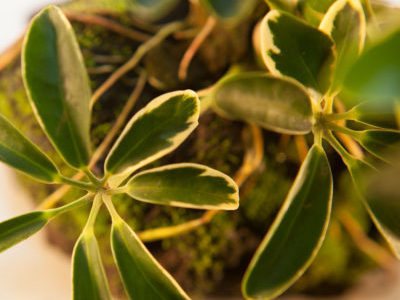

Pests and diseases
Schefflera is susceptible to the same diseases as other indoor plants. Its juice is poisonous, but some parasites are still dangerous - for example, thrips, scale insects, spider mites and mealybugs. The following table will help you understand how to help a sick flower.
| Symptoms | Cause | Treatment |
| Withered and falling leaves. |
| Adjust the conditions of detention and care. |
| Drying and curling leaf ends. | Lack of moisture. | Provide sufficient (but not excessive) soil moisture, spray and wipe the foliage more often. |
| Blackened leaves, the appearance of a rotten smell. | Decay of roots. | Remove the flower from the pot, cut off the damaged roots and dry. Make sure the pot has holes for water to escape. Change the soil, be sure to lay a drainage layer on the bottom. Do not overflow. |
| Yellowed and falling leaves, with small brownish growths on their backs. | Shield. | Isolate the plant. Treat the foliage with soapy water, after covering the ground in the pot with a film. If there is no effect, use insecticidal preparations (for example, thiamethoxam) in accordance with the instructions. |
| Brownish spots on the leaves. | Thrips. | |
| Yellowed, withered, falling leaves, a thin cobweb appears on them. | Spider mite. | Use insecticidal preparations. Maintain air humidity. |
| On the leaves and stems, small white insects, leaving behind a whitish bloom. | Mealy worm. | Collect pests by hand, wash off plaque, spray the plant more often. |
Fertilizer for shefflers
In order for the plant to grow beautiful and healthy, it must be fertilized. Top dressing is carried out with liquid fertilizers for indoor flowers. The frequency of fertilization will depend on the season. During the dormant period from late autumn to early spring, the plant is fertilized once a month, the rest of the time - once every 15–20 days.
The concentration of ready-made dressings may not always meet the needs of the plant. For this reason, experienced flower growers recommend playing it safe by diluting the fertilizer in a lower concentration and fertilizing the tree twice as often. Dry fertilizers for shefflers are not suitable.
Watering and feeding chefs
During the period of active development of the plant, it must be watered quite often, about once every two days. Sheflera does not tolerate overdried soil, so do not wait until the top layer of the soil dries out significantly. But it is not recommended to over-saturate the soil with moisture. In winter, the volumes of irrigation and fertilization decrease, since the plant is dormant. Nitrogen Fertilizer for Indoor Flowers With regard to the quality of the water, it is advisable to let it stand for a few days before watering. Particular attention in caring for the sheflera should be given to feeding. It is required from March to August. What fertilizers are suitable for replenishing the soil with nutrients? Use complex mixtures that contain mineral components. In winter, do not feed the soil.
Scheffler pruning and shaping
Flower pruning is carried out in order to form a lush crown and reduce the vertical size in fast-growing plant varieties. The first pruning should be done when the young plant is slightly older. For this purpose, it is necessary to shorten the apical branches by 4 internodes. It is best to cut branches with a sharp pruner. Sections must be treated with activated carbon.
After the lateral branches have grown, you can begin to form a spherical crown, cutting off the tops of the branches. Cuttings obtained during pruning can be used for propagation. It should be noted that pruning greatly weakens the sheffler, so it must be carried out in several stages.
Mr. Dachnik recommends: Shefflera - a flower for harmony
In esotericism, sheffler is credited with the ability to absorb negative energy.Its presence in the house is believed to bring harmony to the family and prevent discord, as well as improve memory and have a beneficial effect on study and work.
There are even several folk signs associated with the state of the plant:
- darkened leaves mean an excess of negativity in the house;
- falling off - a harbinger of illness or monetary crisis;
- twisted - to a quarrel;
- an unexplained stop in growth - to failures;
- sudden rapid growth - to replenishment in the family.
Scheffler in winter
The dormant period for the plant begins at the end of autumn and lasts until spring. At this time, all processes of the sheffler slow down and it stops growing. Accordingly, the care of her is changing.
During this period, it is better to transfer the tree to a bright room with a temperature of at least + 12 degrees. Watering and sprinkling should be minimized, as well as top dressing.
Possible growing difficulties
Diseases of a flower are often associated with improper care - stagnant water in the soil, temperature drops and poor lighting. Because of this, lightening, drying or falling of leaves may occur, and root rot may develop.
Important! All insecticides
—
substances with high toxicity. When using them, you must use a respirator.
The pests are the same as in most indoor plants:
- spider mite - manifests itself as whitish cobwebs on the back of leaves and stems;
- thrips - cause dark spots on the leaves;
- scabbard - forms sticky mucus on different parts of the bush.
In the initial stage, all these parasites are washed off with soapy water. And in advanced cases, you can save the plant with the help of insecticides. Usually they use "Aktara" or "Aktarin". As far as the shefflera is unpretentious to care, she is just as demanding on reproduction.
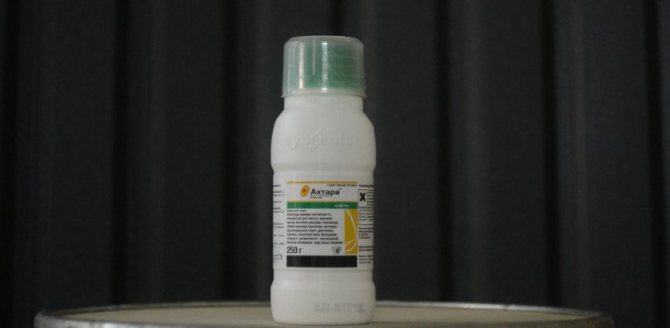

Experienced growers advise to propagate the plant in several ways at the same time, and then choose strong and high-quality sprouts. With proper care, the flower can reach impressive sizes and delight with beauty for many years.
Propagation of shefflers by cuttings
For grafting, shoots are selected from which the stems are already partially stiff and cut off. Then they are treated with drugs that stimulate the growth of the root system. After processing, the cuttings are placed in a mixture of peat and sand.
In order for the planting material to take root, the temperature in the room where it is located should not be lower than + 22 degrees. When the shoots take root, the temperature regime is changed, reducing it to +18 degrees.
After the root system has grown enough, gets stronger and takes up the entire pot, young plants can be transplanted. You can also germinate the root system on cuttings using water. For this purpose, the shoots are placed in cups of warm water and wait until they take root.
After the root system is sufficiently developed to be planted in the ground, the plants are transplanted into separate pots for permanent cultivation.
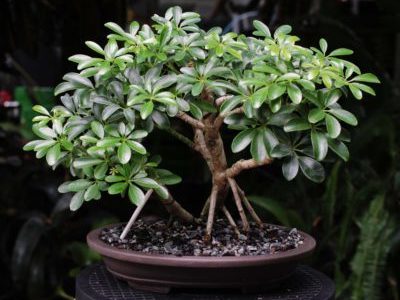

Shefler's flower - cultivation features
Sheflera is a plant in the tropics. It is difficult to create such conditions in the room, but the flower does not pretend to them. It is enough to simply observe the light and temperature conditions, protect it from drafts, water and feed it correctly. For variegated forms, good illumination is especially important, otherwise the plant may lose the brightness of the color of the leaves.
Scheffler from seed at home
The procedure should be started in the second half of winter. Seed material is placed in peat to a depth of 3 to 5 centimeters. After planting, the soil must be watered, covered with foil and the temperature must be from + 22 to + 24 degrees.
From time to time, the film must be removed by airing and spraying crops. When the first leaves begin to appear, the sprouts are transplanted into separate cups and left in the room at 19-20 degrees.
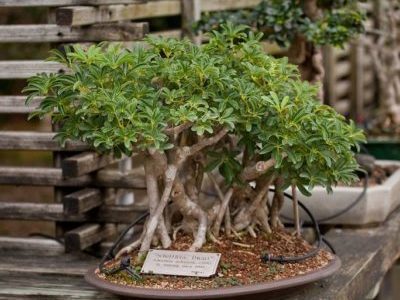

Care
We will learn how to take care of a young cheflera so that she grows and develops well.
Lighting
It is better not to place this flower in tight shaded corners of the house. For good growth and development, the chefler needs an open, sunny space. High-quality lighting is especially important for flowers of variegated varieties: in the shade, bright leaves lose their decorative effect, become ordinary monochromatic.
It would be ideal to place the pot on an east or west windowsill. On the southern windowsill, it is necessary to ensure the shading of the plant from the scorching midday sun.Otherwise, whitish spots-burns will soon appear on the beautiful foliage of the chefs.
Air humidity
You can not keep a pot with a cheflera near working heating batteries. Such a neighborhood negatively affects the condition and decorativeness of the flower: the plant needs a fairly high air humidity.
Temperature
Shefler reproduces best at + 20-23 degrees. However, after rooting, the plant needs a lower temperature: + 16-22 degrees in summer and + 16-18 in winter. Too high temperatures are categorically unsuitable for this flower: it is very difficult for the chefler to endure the heat.
Priming
Sheflera needs a soil of neutral acidity for normal life. It is good if the substrate contains sphagnum and river sand. It is imperative to provide for drainage in the pot: its layer should be at least 2 cm. Standard materials are suitable as drainage: expanded clay, fine gravel.
Watering
The plant does not tolerate excessive waterlogging, however, it is better to avoid drought. Regular watering is recommended, but only after the earthen lump dries out noticeably from above.
Along with watering, spraying is also recommended: they help maintain optimal air humidity, and they also remove dust from the leaves. You can also wipe the foliage with a cloth soaked in water and occasionally shower the flower.
Watering and spraying the plant is necessary with water only warm and settled. You can also use thawed, rainwater.
Top dressing
For successful development, additional nutrition is necessary for the chef. You need to introduce top dressing in liquid form. Ready-made compositions such as Novosil, Pocon +, Peat Oxidat, etc. are suitable. However, it is recommended to make the concentration of fertilizers weaker than what is written in the instructions. The chefler is not fed with dry granules. Application frequency: in summer 4 times a month, in winter 2 times a month.
Transfer
If the shefler belongs to undersized varieties, she is transplanted every second year. Large varieties are transplanted much less often - every 4-5 years. However, it is necessary to look at the condition of the plant: if roots peep out of the drainage holes of the pot, it is better not to delay the transplant. If you delay the transplant, the chef will not die, but it will grow and develop much more slowly.
Increase the volume of the pot with each procedure. Make sure that the new container is equipped with drainage holes: stagnant water is detrimental to the chefler.
The transplant of an adult chefler is always carried out by the transshipment method, as the most gentle. After the plant is successfully placed in a new pot, water the substrate abundantly to facilitate and speed up the adaptation process.
Pruning
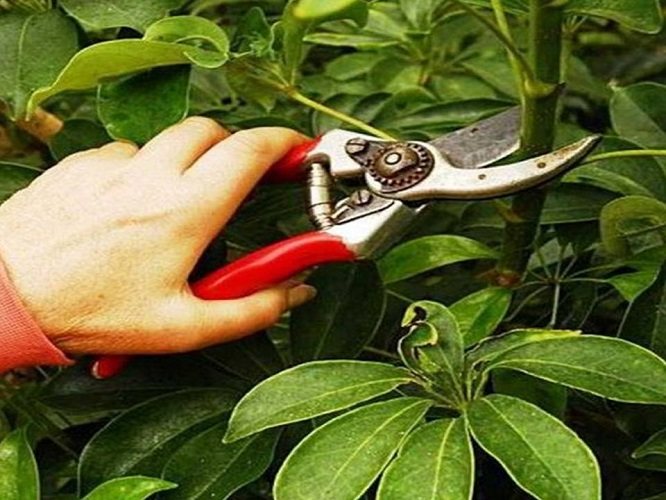

If the chef is not cut off, it will begin to stretch up uncontrollably, becoming less beautiful and lush because of this. Therefore, usually the top of the plant is cut off or pinched, thereby forcing the flower to branch more actively, to form lateral shoots. Note that the shefler tolerates the trimming procedure quite adequately, recovering quickly after it.
You can form a spherical crown of a plant, make a miniature semblance of a tree, a bush from the cheflera. Some flower growers plant several chefs in one container, then intertwining their crowns with each other.
Reproduction of shefflers by air layers
To use this method of reproduction, a small incision is made in the outer layer of the trunk, the resulting scar is covered with moist sphagnum, which should be constantly moistened. Then the barrel is wrapped in polyethylene.
After two months, roots appear at the site of the incision. The cut is neatly cut and transplanted into a separate pot.
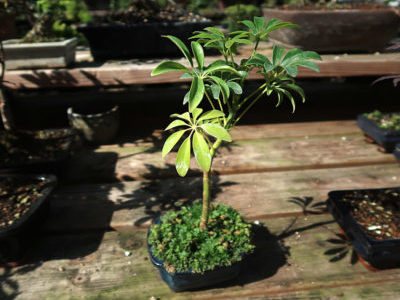

Seeds
Much more troublesome and time-consuming procedure than the previous one. That is why seed reproduction is chosen only if there is no way to get the stalk of the chefs. We recommend purchasing seeds in the store, since it is almost impossible to get them yourself.Even if the seeds are obtained, there is no guarantee that they will sprout.
Planting seeds is best scheduled for February: so that by spring-summer the seedlings have already grown up and can develop normally under conditions of long daylight hours and warmth.
Procedure
- Before planting, the seeds are soaked either simply in warm water for a day, or in a weak solution of the Epin stimulant, Heteroauxin.
- Sowing is carried out in a wide and rather deep container, two-thirds filled with the substrate.
- The seeds should be laid out in shallow holes and sprinkled with a little soil on top.
- A film is put on the container for a greenhouse effect. The plantings should be ventilated regularly, the soil should be moistened if necessary.
- When the first full-fledged leaves appear on the seedlings, the shoots dive into individual pots.
Scheffler leaf propagation
This breeding method is suitable for experienced growers. To obtain planting material, you should tear off a large leaf plate from an adult plant and place it in a growth stimulator solution. Then the workpiece must be placed in a warm place and covered with polyethylene.
After three weeks, the polyethylene layer should be gradually removed, reducing the temperature to 20 degrees. When the leaf adapts, it needs to be transplanted into a prepared pot with drainage and substrate.
Which of the breeding methods to choose, each grower will decide for himself.


Signs
"Kind vampire", although it refers to plants with poisonous sap, normalizes the energy of the house. It is believed that it absorbs only negative energy, cleaning the home in this way.
By placing the plant in the bedroom, you harmonize relationships and normalize energy flow. If the plant withers, which is associated with dropping or yellowing of the foliage, the atmosphere in the house is far from positive and harmonious.
If the plant has started to grow quickly, wait for an addition to the family.
Sheffler diseases and pests
The most common sheffler ailment is rot... It infects the plant if the grower floods it, keeps it cold and draughty, or overfeeds the tree. All of the above reasons lead to the fact that the plant sheds leaves, withers, black spots appear on the leaf plates..
To get rid of rot, the plant must be transplanted into a new pot and substrate, after first sorting out the root system and removing the damaged areas. To finally kill fungal spores, the roots should be kept in a weak solution of manganese for 20 minutes, after which the plant can be transplanted into the prepared soil.
- If a Sheffler leaves start to turn yellow it means that direct sunlight fell on them and the plant was burned. You can help the tree by removing it to a slightly shaded place.
- Shefflers' leaf plates darken with a lack of light, therefore, to avoid this problem, the plant must be moved closer to the sun.
- If leaves fall, the shefflera dries, grows poorly or does not grow at all - the reason is improper care of her. Only by creating a microclimate favorable for growth and development can you eliminate all of the above problems.
In addition to diseases, the plant is susceptible to attack spider mite, thrips and scabbards... The first signs of damage by these pests is the stickiness of the leaves. By releasing its poisonous juice, the Schefflera tries to protect itself from harmful insects on its own.
To destroy pests, the plant can be sprayed with a soda solution and wiped with a soapy solution. Also, the sheffler should be treated with Actellik insecticide according to the instructions on the package.
As you can see, caring for an exotic green pet is a snap. Observing all of the above recommendations, you will get a beautiful and healthy plant that will delight you with decorative leaves and fast growth, eventually turning into a luxurious tree with a dense and luxurious crown.
Sheflera turns yellow, sheds leaves, turns black
The painful condition of the flower is usually caused by errors in care. The reasons for these phenomena can be different. In order for the plant to regain its decorative effect, care will have to be adjusted.
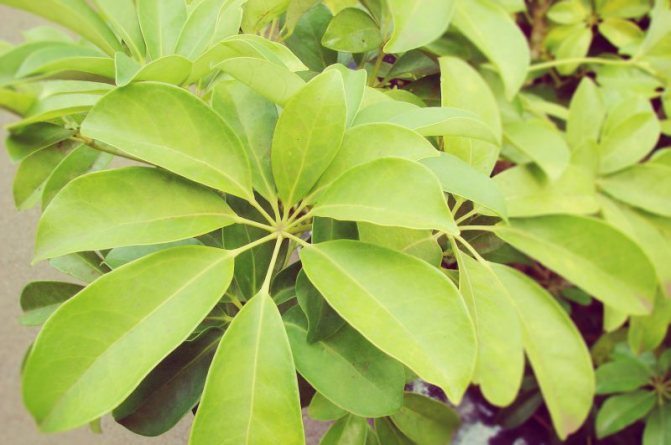

- The plant responds by dropping leaves to temperatures that are too high in summer or too low in winter. Another reason is over-watering. The plant also loses its leaves if it does not have enough light.
- Yellow leaves can be a signal that pests have appeared on the flower. If they are not there, then the flower is simply too hot.
- The leaves of the cheflera turn black if the root rots, which happens with excessive watering. The plant is removed from the pot, the damaged roots are cut off and sprinkled with crushed coal, dried and planted again. Dark spots, starting from the tips, appear on the chefler with low air humidity and a lack of moisture in the pot.
Photo examples of Scheffler's flower
Why do shefflers have leaves falling and what to do
Scheffler, like any other plant, after purchase, takes time to adapt to a new place of residence, which differs in the level of humidity, the amount of light and temperature indicators.
The new owners of the shefflers have a question why the leaves of the flower fall after the purchase. In most cases, you should not worry about this, since this is a completely normal plant reaction to a new place of residence.
For a softer adaptation, you should remember the main rules:
- Do not replant the plant for 1 month.
- Do not feed him.
- Provide optimal conditions with adequate lighting and temperature.
It is believed that if the leaf fall during the first month after the change of location stopped and new greens appeared, then the plant successfully survived the adaptation period.
If, after a month in new conditions, the shefflers continue to fall off the leaves, which is recommended in this case:
- Add in 200 ml of water for irrigation 1 drop of "Cycron".
- Spray 2 times a day with water (200 ml + 2 drops of "Epin").
- Location: light, but no sun.
- Temperature: it's warm all year round. The soil is warm.
- Air humidity: high, better in a confined display case space.
In most cases, this helps to solve the problem of dropping and yellowing of foliage.
Shefler in the house: signs and superstitions
Sheflera is one of those cultures with which various signs are associated. It is believed to be capable of absorbing negative energy. If a person is disturbed by sad thoughts, it is recommended to spend more time next to this tree. Sheflera is able to absorb all anxieties, neurotic states, bring harmony into relationships. Therefore, a bedroom would be a good place for her. Also, the plant promotes mental activity, the assimilation of knowledge.
Shefler is considered a predictor of the future. If the leaves darken, it means that a lot of negative energy has accumulated in the house. Falling leaves speaks of impending financial problems or illness of someone living in the house. Curling of leaves, cessation of growth may indicate future failures. But if the chef began to grow intensively, then it is worth waiting for replenishment or some kind of profit.
Sheflera won the love of flower growers due to her unpretentiousness and beautiful decorative foliage. To achieve a lush crown and avoid growing problems, it is necessary to provide suitable conditions for the plant and give it a little attention.
Video - recommendations on growing, transplanting and fertilizing, crown formation and reproduction Sheflera:
Crown formation
If the sheffler is not pruned, it will grow straight up. A smooth, upright tree with lush foliage, beautiful but not sophisticated. Forming a flower will take time, skill and taste. In advance, come up with a pattern of a deciduous hat, variations of a trunk or bonsai and observe.
Treat sections with immunomodulators or other means. Don't forget that lighting also plays a big role in adding volume.Remember, variegated pets absorb much more light!
After pruning, be attentive to all changes, the trees are still weak, capricious, and susceptible to pests.
Lighting
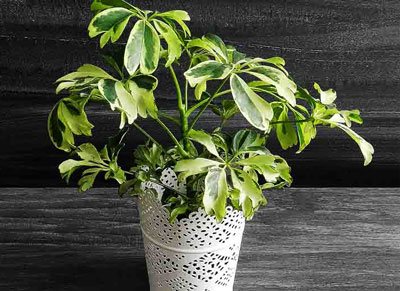

The plant follows protect from direct sunlight in summer, otherwise burns in the form of yellow spots occur.
And at the same time, the north window is contraindicated.
Best option: southeast or southwest.
When the sun is very strong, you need to move the pot deeper into the room.
In winter, the southern window is the best option.
Advice: Sheffler loves the sun, so the north window is an unacceptable option for her. But it must be protected from direct sunlight.
Growing conditions
More than 590 Scheffler species are found in the wild. At the same time, the plant is large in size, and many species are able to grow in natural conditions up to 40 meters in height.
In indoor floriculture, such gigantic varieties, of course, are not used. For the most part, in home cultivation, a maximum of 1.5-2 meter Schefflers is preferred.
Interesting!Sheffler can often be found in large flowerpots installed on the floor. The plant in adulthood is striking, adds aesthetics to any room, but most of all to office and public spaces.
Shefflers come with variegated leaves, boat leaves, or leaves with an interesting, wavy border. Therefore, the variety of forms of the future plant is amazing and, perhaps, can easily satisfy any request.
The key feature of the Scheffler bush is lush greenery, with little or no flaw.... The leaves are formed by rosettes and brushes, tightly covering the trunk and branches.
Shefflera's flowers are very small. In nature, they are collected in a bunch like bunches of grapes and often stand out poorly against the background of fairly large leaves. In captivity, it is almost impossible to achieve flowering, and even more so fruiting Shefflera.
Temperature
But even without flowering, Scheffler looks attractive. In many ways, the whole point is in the large, often interesting in shape, leaves.
And in order for the plant to always look neat and healthy, you need to comply with some requirements for the surrounding conditions. The most important thing is the temperature background. It may seem that Schefflera, due to tropical growth, loves high temperatures, but this is far from the case. Under natural conditions, the flower grows in shady tropical forests, so it loves just the cool.
- In summer, the optimum temperature is + 20-22 ° C.
- In winter, the plant feels good from +14 C to +18 C.
And note that Schefflera is more likely to be tolerated by a slight drop in temperature than a sharp jump up. In extreme heat, it is not uncommon for the flower to shed most of the foliage, after which it takes a long and difficult time to recover.
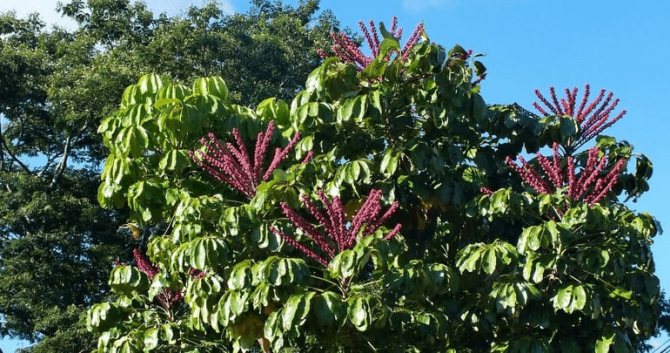

Air humidity
Another important point to watch out for is air humidity. In the case of the Scheffler flower, you will have to keep a container of water nearby almost all year round. Naturally evaporating, the water will increase the humidity of the air to the required limits.
You can also give preference to modern humidifiers, which both measure the humidity and effectively increase it to the set values. But this option will require financial investments and will not suit everyone.
Lighting
All varieties prefer cultivation without direct sun exposure. But at the same time, they are extremely jealous of the lighting level. For example, with active growth, Scheffler may well need even artificial additional lighting in the cold season.
The optimal daylight hours for Schefflera are 10-12 hours. Based on this, the flower feels best closer to the windows, but with the obligatory shading from direct sunlight by screens or other colors.
Choosing a place where to put a flower pot
In general, plants, already in adulthood, feel great even in the corners of rooms, far from windows.
But it is better to grow a young flower for the first time in good lighting. For this reason, the pot is best placed on windows facing the west or east side, where daylight hours are sufficient, but the ultraviolet radiation is less intense. On the other hand, if the sun is too aggressive and hits the foliage, it will not be superfluous for Scheffler to shade.
Certain varieties can be grown on north-facing windows. But this only applies to those species that have standard green foliage. The variegated varieties on the northern side will lose their identity and will be colored in the usual green hue.
But the southern windows for Shefflera are suitable only in the cold season. In summer, the sun is too aggressive and hot there.
What does it look like in the interior?
Schaeffler's room looks harmonious in almost any design. Its main feature - lush and large foliage - will invariably complement and decorate the room.
Inscribing a Scheffler flower will definitely work out in a classic interior, as well as any other outstanding decoration.
It is known that the plant looks good even in modern types of design, although there is a noticeable commitment to general minimalism and high functionality in them.
Varieties
The trunks can be braided.
Usually, in indoor conditions, flower growers grow the following types of chefler:
- Sh. Radiant (Schefflera actinophylla) - in nature it can grow up to 12 m. The plant has a pronounced tree-like shape, a powerful trunk has a gray-brown color. Oval-pointed leaves are located on long reddish petioles, each leaf blade consists of 14-16 separate segments. The leaves are dark green with a malachite tint, have a leathery surface and a bright shine. The cultivar blooms with yellow or scarlet flowers, collected in a brush.
- S. eight-leafed (Schefflera octophylla) - octopus tree. The variety is named for its milky-colored hanging petioles. Leaves at a young age are yellowish. Adults are green. Flowers are yellow-green with long stamens.
- Sh. Treelike (Schefflera arboricola) - found in Australia and New Guinea. A low, graceful plant with many stems and root suckers. Young shoots have a herbaceous color, adult stems acquire a brown tint over time. The leaves consist of 16 green plates. This species includes varieties with yellow leaf markings (Gold Capella).
- Sh. Palmate (Schefflera digitata) - the natural habitat is located in New Zealand, where sheflera grows to a height of 8 m. The leaf blades are divided into 10 parts, the length of the leaves is up to 35 cm, along the edges are covered with rare denticles.
In indoor conditions, the chefler can be grown in the form of a tree or a bush, plants with intertwined trunks are distinguished by high originality and decorativeness.
Sheflera - signs
Signs and superstitions are associated with the shefflera. For example, she is considered almost a vampire. Indeed, in nature, other plants do not get along with it, it is very aggressive.
The darkening on the leaves is attributed to someone's negative energy. It is enough to check the conditions of keeping and the condition of the roots to make sure that this is not the case. After all, even according to Feng Shui, it is recommended to put the plant in the southern part of the office.
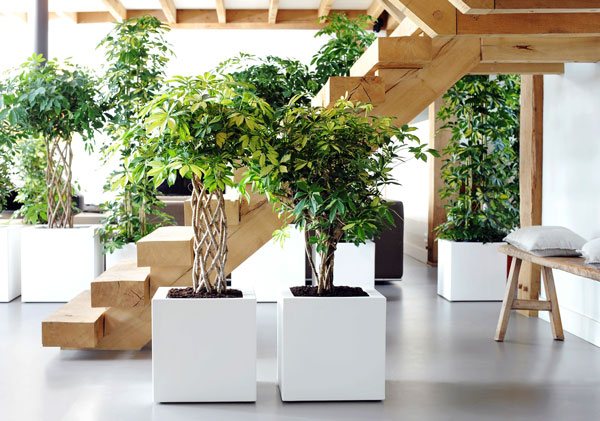

Schefflera attracts clients to the office... Let this omen be true. After all, the beauty of a plant, for example, such a variegated species as Arboricola with its overflows from pearl to yellow, cannot fail to attract attention.
Useful properties of shefflera
Schefflera improves the environmental conditions of the room in which it grows: it increases the humidity of the air and saturates it with aero ions and ozone, and removes benzene.
The umbrella tree contains toxic substances that irritate the skin and mucous membranes. Therefore, it is better to keep it away from small children and pets, and after contact with the plant, wash your hands thoroughly.
Reasons why shefflera sheds leaves, and what to do
Scheffler, despite his unpretentious care, can still suffer from various diseases. Many of them are helped by insecticidal and fungicidal treatment of the plant. But if the main reason for the problems that arise is care errors, then the first thing to do is to eliminate it.
If the shefflera sheds leaves, the cause is over-watering. What to do in this case: Try to reduce its hydration. Adhere to the basic rules of watering:
- As needed (drying of the topsoil).
- Standing water, room temperature.
- In warm weather, watering is more frequent, in cold weather it is halved.
Excessive hydration of the plant, if not noticed in time, often leads to the fact that the root system of the flower begins to rot. At the same time, the leaves begin to turn black on the sheffler, dark spots appear on the cuttings and trunk.
The only salvation for the plant in this case is a transplant with the removal of decayed elements of the root system. At the same time, it is recommended to replace the earthen lump with new soil, which must be disinfected without fail.
Radiant
Star-shaped or star-leaved. The color is dark green, interspersed with shades. Wax sheet, 16 pieces in one umbrella. The length is over 20 centimeters. Found in Australia, on the islands of New Guinea, Java. Natural specimens grow over 9 meters.
Blooms in huge racemose, star-like inflorescences. In cozy rooms it can reach a height of two meters, but it grows slowly. 6-7 leaf halves.
Frequent mistakes
- Lack of lighting for Scheffler is the biggest and most common mistake that always leads to problems in growth and soreness of the bush. So, the leaves can be faded, lose color (if initially they should be variegated). The trunk is curved and thin.
- Schefflera sheds foliage intensively, usually for two reasons: either he is too cold in the room, or too hot.
- Leaves dry out at the tips or brown spots appear on them. Often the reason lies in the excessive waterlogging of the plant.
- Light spots or even withered areas begin to appear on the leaves - this is a sign of excessive illumination or even direct sunlight.
How to stimulate flowering?
The first condition for normal flowering and even just the beginning of this process in Scheffler is the presence of bright light, long daylight hours in general. At some latitudes, for this reason, additional lighting may be required in spring and autumn.
Secondly, it is important to withstand the coolness, prevent severe overheating and moisten the soil as much as necessary, trying not to go to extremes.
In general, you should not be upset if Schefflera still does not bloom, because only a few gardeners are trying to achieve the appearance of flowers in captivity, and then mostly by accident.
On the other hand, if Schefflera did bloom, then the whole process proceeds independently. There is no need to resort to any additional measures.
Personality and popular types
Sheffler is loved for its unusual foliage, called a "tropical umbrella". The leaves, also called lobes, sprout from one petiole on a branch and look like a palm with spread fingers or an umbrella. Slices and patterns gave the name to some varieties, eight-leaf, finger. Also called umbrella.


The leaflet is divided into 4-16 halves. Painted in dark green, variegated, interspersed with white-beige, yellow shades. In nature, shefflers bloom in a peculiar way. Paniculate or racemose inflorescences. Indoor flowering is rare, and if it blooms, it releases panicles with white-beige flowers.
Known and bred Scheffler varieties are conventionally divided into two types:
- Potted.
- Soil or wild.
We buy the sheffler in the store
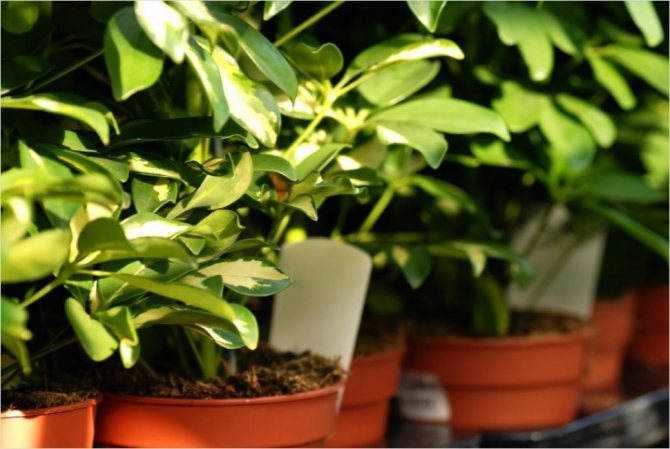

When buying a sheffler in a store, you need to properly inspect the plant.
Schefflera is a beautiful plant that is appreciated by flower growers for its decorative effect.When purchasing it in a store, you need to inspect and make sure that it is a healthy copy. Its leaves should be bright, glossy and firm, and the crown should be dense and evenly leafy.
Pay attention to whether the plant is infected with pests and diseases - you should refuse to buy a sick specimen. In order to understand if the shefflera is healthy, examine her stem and leaves on both sides. Do not buy a plant whose shoots are too elongated, or, conversely, depressed.
See also: Gerberas: how to grow a tropical flower at home. Description, varieties, care, reproduction, possible diseases (50+ Photos & Videos) + Reviews
Description of the plant
Amateur flower growers appreciate the chefler's arboricol for spectacular leaves, which are collected in brushes or umbrellas 4 - 12 segments. This creates a lush bush, and when pruned in time, it is a large ball of greenery. There are equally colored varieties and variegated ones with white strokes.
A chefler's flower is theoretically capable of blooming, but this is never observed in indoor conditions, therefore, all the attention of flower growers when leaving will be directed to maintaining the healthy state of the foliage.


Usually several bushes are planted in a pot at once to weave the stems for support and beauty. If only one shoot is planted, then it is strengthened with a support, since it is not sufficiently developed in width and the bush can break.
How do diseases manifest
The foliage is strewn with dark and white dots, cobwebs, dark scales. The surrounding area may become covered with droplets of sticky moisture.
Typical pests:
- aphid;
- thrips;
- spider mite;
- shield.
The above methods will help you deal with them.
In the case of an excess of moisture, rot appears. Drain, if soil is spoiled, replace.
Care errors and their elimination
Problems with the boss arise more often due to incorrect content. The plant reacts painfully to stagnant moisture in the soil, lack of lighting, dry air, temperature changes.
Common problems and how to fix them:
| Problem | The reasons | Decision |
| Shedding leaves | High or low temperature, waterlogging | Avoid sudden temperature jumps, water sparingly, avoid liquid stagnation |
| Fading of leaf plates, light spots on the surface | Incorrect lighting | Do not put the flowerpot in direct sun, as well as in the shade, diffused light is better for the plant |
| Drying out the tips of the leaves | Dry air, lack of moisture in the soil | Spray the leaves regularly, put a pallet with wet expanded clay to increase moisture, prevent the soil from drying out |
Reproduction


Sheffler can be propagated in several ways.
Indoor sheffler can be propagated in several ways:
- seeds
- cuttings
- layering
Let's dwell on each of these methods in more detail.
back to menu ↑
See also: Lemon: description, care, growing from the seed at home, recipes for vitamin juice and lemonade + Reviews
Seed propagation
Since the sheffler does not bloom and bear fruit at home, for this method of propagation, you need to purchase ready-made seeds. They are sown in the ground in winter, in January or February. Before sowing, the soil must be disinfected, and the seeds must be soaked in warm water with the addition of a germination stimulator.
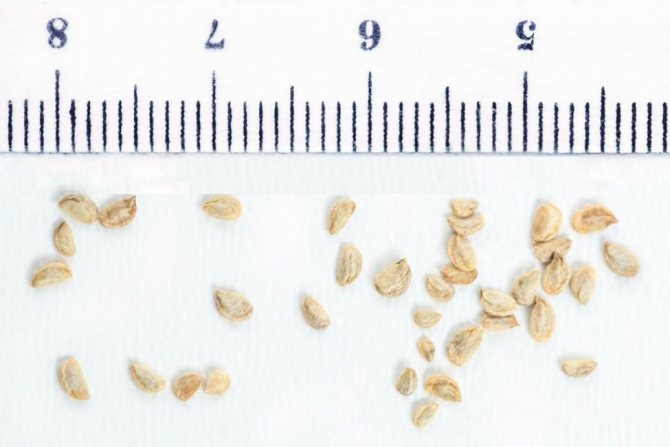

Sheffler seeds
After sowing the seeds, the substrate is watered, a greenhouse is made from the pot, covered with plastic wrap, and placed in a warm place with a temperature of 20 - 24 ° C. The greenhouse must be regularly ventilated and kept constant moisture content of the substrate.
Bottom heating is recommended for faster germination. After the seedlings have two or three leaves, each plant is transplanted into a separate small pot. The next transplant must be carried out after the roots of the plant have occupied the entire volume of the pot.
When propagating by seeds, there is no guarantee that you will get exactly the sheffler variety from which the seeds were collected... To get a plant similar to the mother, you need to use vegetative propagation - cuttings and layering.
back to menu ↑
See also: Types and varieties of home cacti with names and descriptions, care (100+ Photos): flowering, with leaves and without thorns + Reviews
Propagation by cuttings
Household shefflers are cuttings during the warm season, in the spring or summer months. As a cutting, a young semi-lignified apical shoot of a plant is suitable, which is cut with a sharp knife so that 3-6 leaves remain on it.
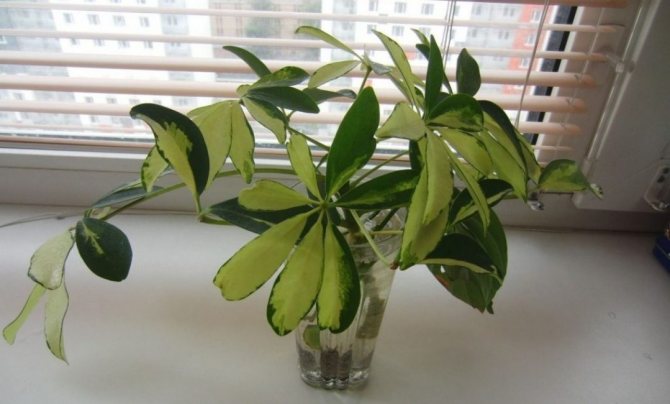

Sheffler cuttings
From the bottom, which will be immersed in the earthen mixture, it is necessary to remove the leaves. The cuttings are rooted in a moist substrate. Before planting, they need to be treated with a rooting stimulant. The treated cuttings are planted in a pot with a substrate at a temperature of 22 to 26 ° C and covered with foil to create a greenhouse.
You can also root the cuttings in a container of water, placing it in a bright place, protected from direct sunlight. It is necessary to constantly monitor the water level in the tank. Within about two weeks, the cuttings will take root and will need to be planted permanently in a pot with drainage and a suitable earth mix.
back to menu ↑
See also: Anthurium - exotic colors at home: species, reproduction and care + Reviews
Reproduction by layering
For reproduction of domestic shefflers by layering, you need to take a long shoot without leaves and make a deep incision in the bark. After that, the damaged area should be wrapped with moss soaked in root or phytohormones, and covered with cling film on top.
Aerial roots shefflers
Moss needs to be moistened regularly. It is necessary to wait for the roots to appear: this usually occurs within 1.5 to 2 months. After that, the shoot is carefully cut with a sharp knife below the level of the roots, the cut is treated with wood ash and the plant is planted in a separate pot. This method is used for adult large specimens.
back to menu ↑
See also: Hydrangea (90+ Photos) - description, outdoor care, reproduction, transplant, disease (Video) + Reviews
The reason for the appearance of brown spots on the leaves of shefflera
Another reason for the appearance of brown spots on the leaves of shefflera is drafts.
Important! Do not place on window sills of opening windows. Draft is deadly! In most cases, by eliminating this negative factor for the flower, it is possible to stop the appearance of changes.
A severely "cold" sheffler, in addition to brown spots on the leaves, can start and shed them. The amount of fallen greenery can reach ten pieces per day. For treatment, flower growers recommend creating greenhouse conditions for the plant.
To do this, it is wrapped in polyethylene, which should not come into contact with the foliage. Reduce watering by replacing it with spraying greens up to 3 times a day. Once a week "Cicron" is added to the water. Such rehabilitation must be carried out until the plant produces new foliage.
Woody
She is "tree-like". In Australia, New Guinea, this vine is loved and used to create compositions and green walls. Blooms only after 8 years of life. The number of slices is 7-16 pieces. Instances derived from it are called: Melanie, Nora, Janine, Beautiful, Golden Chapel, Diana, Green Chapel and many others.
Coloring varies. From wood shefflers create standard fences, compositions, planting several shoots together. The grown stems are connected, looked after, intertwined with each other all the time. The exotic bred by breeders is liked by flower growers.
Important! Before purchasing, transplanting, pruning and propagating flowers, read various sources.
Top dressing
Sheflera needs constant feeding, the basic rules and features of such care are given below:
- The introduction of liquid fertilizers intended for flowering plants into the soil is carried out at a frequency of once every 10 days. The break is made only from December to February, while the plant is in a dormant state.
- From spring to autumn, spraying from a spray bottle with a solution of bioregulators is carried out monthly. Among the most suitable agents are immunocytophyte, zircon or epin.
Botanical reference
The variety with white spots on the leaves looks very elegant.
Sheflera belongs to the Araliev family, representatives of the genus are found in the countries of Oceania, in Australia, in the regions of Southeast Asia. In nature, cheflers grow to a significant size, usually the height of trees and shrubs can reach over 2.5 meters.
Among the shefler, there are not only trees and shrubs, which eventually lose leaves in the lower part of the trunk, carrying a thick cap of umbrella leaves on the top of the head, some representatives of the genus have a liana-like shape.
The leaves of the plant can have a dense green color, there are varieties with variegated leaves (white, cream or yellow edging of the leaves along the edge).
In room culture, chefs have long been used to decorate premises, while it is worth remembering that all parts of the plant are poisonous, you should be careful when growing them.


